The Development Progress of Surface Structure Diffraction Gratings: From Manufacturing Technology to Spectroscopic Applications
Abstract
:1. Introduction
2. High Diffraction Efficiency and Damage-Resistance Threshold Gratings
2.1. Metal-Film Reflection Gratings
2.2. Multilayer-Dielectric-Film Grating
2.2.1. Multilayer-Dielectric-Film Reflection Grating
2.2.2. Multilayer Dielectric Film Transmission Grating
3. Progress in Grating Fabrication Technology
3.1. Mechanical Scribing Technology
3.2. Holographic Exposure
3.3. Electron Beam Exposure
3.4. Nanoimprinting
4. Conclusions
Author Contributions
Funding
Conflicts of Interest
References
- Zhang, J.; Peng, H.; Fu, X.; Liu, Y.; Qin, L.; Miao, G.; Wang, L. CW 50W/M2 = 10.9 diode laser source by spectral beam combining based on a transmission grating. Opt. Express 2013, 21, 3627–3632. [Google Scholar] [CrossRef] [PubMed] [Green Version]
- Vijayakumar, D.; Jensen, O.B.; Ostendorf, R.; Westphalen, T.; Thestrup, B. Spectral beam combining of a 980 nm tapered diode laser bar. Opt. Express 2010, 18, 893–898. [Google Scholar] [CrossRef] [Green Version]
- Daneu, V.; Sanchez, A.; Fan, T.Y.; Choi, H.K.; Turner, G.W.; Cook, C.C. Spectral beam combining of a broad-stripe diode laser array in an external cavity. Opt. Lett. 2000, 25, 405–407. [Google Scholar] [CrossRef]
- Stankeviius, L.; Tamuleviius, T.; Utautas, A.; Juodnas, M.; Tamuleviius, S. Diffraction efficiency optimization of multilayer dielectric mirror-based gratings for 1030 nm femtosecond lasers. Opt. Laser Technol. 2020, 126, 106071. [Google Scholar] [CrossRef]
- Martz, D.H.; Nguyen, H.T.; Patel, D.; Britten, J.A.; Menoni, C.S. Large area high efficiency broad bandwidth 800 nm dielectric gratings for high energy laser pulse compression. Opt. Express 2009, 17, 23809. [Google Scholar] [CrossRef] [PubMed]
- Strickland, D.; Mourou, G. Compression of amplified chirped optical pulses. Opt. Commun. 1985, 56, 219–221. [Google Scholar] [CrossRef]
- Biao, L.; Wen, Z.Y. Design and experiment of spectrometer based on scanning micro-grating integrating with angle sensor. Infrared Phys. Technol. 2014, 62, 29–33. [Google Scholar] [CrossRef]
- Shatokhin, A.N.; Kolesnikov, A.O.; Sasorov, P.V.; Vishnyakov, E.A.; Ragozin, E.N. High-resolution stigmatic spectrograph for a wavelength range of 12.5–30 nm. Opt. Express 2018, 26, 19009. [Google Scholar] [CrossRef]
- Thomae, D.; Hönle, T.; Kraus, M.; Bagusat, V.; Deparnay, A.; Brüning, R.; Brunner, R. Compact echelle spectrometer employing a cross-grating. Appl. Opt. 2018, 57, 7109–7116. [Google Scholar] [CrossRef]
- Yin, K.; Hsiang, E.L.; Zou, J.; Li, Y.; Yang, Z.; Yang, Q.; Lai, P.C.; Lin, C.L.; Wu, S.T. Advanced liquid crystal devices for augmented reality and virtual reality displays: Principles and applications. Light Sci. Appl. 2022, 11, 161. [Google Scholar] [CrossRef]
- Gaylord, T.K.; Moharam, M.G. Thin and thick gratings: Terminology clarification. Appl. Opt. 1981, 20, 3271–3273. [Google Scholar] [CrossRef] [PubMed]
- Molesky, S.; Lin, Z.; Piggott, A.Y.; Jin, W.; Vucković, J.; Rodriguez, A.W. Inverse design in nanophotonics. Nat. Photonics 2018, 12, 659–670. [Google Scholar] [CrossRef] [Green Version]
- Yin, K.; Lee, Y.H.; He, Z.; Wu, S.T. Stretchable, flexible, rollable, and adherable polarization volume grating film. Opt. Express 2019, 27, 5814–5823. [Google Scholar] [CrossRef] [PubMed]
- Yin, K.; He, Z.; Wu, S.T. Reflective Polarization Volume Lens with Small f-Number and Large Diffraction Angle. Adv. Opt. Mater. 2020, 8, 2000170. [Google Scholar] [CrossRef]
- Loewen, E.G. Diffraction gratings: M. C. Hutley. Precis. Eng. 1983. [Google Scholar] [CrossRef]
- Yamada, I.; Nishii, J.; Saito, M. Modeling, fabrication, and characterization of tungsten silicide wire-grid polarizer in infrared region. Appl. Opt. 2008, 47, 4735–4738. [Google Scholar] [CrossRef]
- Peng, S.; Quan, L.; Wu, J. Sub-wavelength metal polarization gratings array used in polarization imaging. In Proceedings of the SPIE—The International Society for Optical Engineering, Beijing, China, 17 November 2010; Volume 7848. [Google Scholar]
- Jin, Q.; Liu, Q.; Wu, J.; Cheng, Y.; Sheng, Y.; Yu, C.; Chen, L. Design and Fabrication of nanowire-grid polarizer in near-infrared broadband. Proc. SPIE 2012, 8556, 553–565. [Google Scholar]
- Jing, N.; Li, H.Q.; Wen, L. Broadband polarizer or band-pass filter based on a dielectric grating with top and bottom metallic coverings. In Proceedings of the SPIE—The International Society for Optical Engineering, Beijing, China, 13 November 2014; Volume 9277. [Google Scholar]
- Xia, Z.; Huang, H.; Kong, F.; Wang, L.; Jin, Y. Varied laser induced damage phenomena of gold coated gratings for pulse compression. Opt. Lasers Eng. 2017, 95, 42–51. [Google Scholar] [CrossRef] [Green Version]
- Xia, Z.; Wu, Y.; Kong, F.; Jin, Y. Using a cover layer to improve the damage resistance of gold-coated gratings induced by a picosecond pulsed laser. Appl. Surf. Sci. 2018, 436, 362–366. [Google Scholar] [CrossRef]
- Zhu, S.Q. Diffration Grating; Machine Press: Beijing, China, 1986. [Google Scholar]
- Available online: http://www.llnl.gov/nif/lst/diffractive-optics/multilayer.html (accessed on 27 November 2013).
- Available online: http://www-conf.slac.stanford.edu/lepcf/paper/05_Early.pdf (accessed on 17 April 2000).
- Kessler, T.J.; Bunkenburg, J.; Huang, H.; Kozlov, A.; Meyerhofer, D.D. Demonstration of coherent addition of multiple gratings for high-energy chirped-pulse-amplified lasers. Opt. Lett. 2004, 29, 635–637. [Google Scholar] [CrossRef]
- Available online: http://www.jobinyvon.fr/frdivisions/Gratings/dielectric_pulse.html (accessed on 23 May 2013).
- Perry, M.D.; Patterson, F.G.; Weston, J. Spectral shaping in chirped-pulse amplifification. Opt. Lett. 1990, 15, 381–383. [Google Scholar] [CrossRef] [PubMed]
- Perry, M.D. Multilayer dielectric gratings: Increasing the power of light. Sci. Technol. Rev. 1995, 25–33. [Google Scholar]
- Perry, M.D.; Shannon, C.; Shults, E.; Boyd, R.D.; Britten, J.A.; Decker, D.; Shore, B.W. High-efficiency multilayer dielectric diffraction gratings. Opt. Lett. 1995, 20, 940–942. [Google Scholar] [CrossRef] [PubMed]
- Shore, B.W.; Perry, M.D.; Britten, J.A.; Boyd, R.D.; Feit, M.D.; Nguyen, H.T.; Chow, R.; Loomis, G.E.; Li, L. Design of high-efficiency dielectric reflection gratings. J. Opt. Soc. Am. A 1997, 14, 1124–1136. [Google Scholar] [CrossRef]
- Hehl, K.; Bischoff, J.; Mohaupt, U.; Palme, M.; Schnabel, B.; Wenke, L.; Bödefeld, R.; Theobald, W.; Welsch, E.; Sauerbrey, R.; et al. High-efficiency dielectric reflection gratings: Design, fabrication, and analysis. Appl. Opt. 1999, 38, 6257–6271. [Google Scholar] [CrossRef] [PubMed]
- Wei, H.; Li, L. All-dielectric reflection gratings: A study of the physical mechanism for achieving high efficiency. Appl. Opt. 2003, 42, 6255–6260. [Google Scholar] [CrossRef] [PubMed]
- Destouches, N.; Tishchenko, A.V.; Pommier, J.C.; Reynaud, S.; Parriaux, O.; Tonchev, S.; Ahmed, M.A. 99% efficiency measured in the -1st order of a resonant grating. Opt. Express 2005, 13, 3230–3235. [Google Scholar] [CrossRef] [PubMed]
- Neauport, J.; Lavastre, E.; Razé, G.; Dupuy, G.; Desserouer, F. Effect of electric field on laser induced damage threshold of multilayer dielectric gratings. Opt. Express 2007, 15, 12508–12522. [Google Scholar] [CrossRef] [PubMed] [Green Version]
- Feit, M.D.; Rubenchik, A.M.; Shore, B.W.; Stuart, B.C.; Perry, M.D. Laser-induced damage in dielectrics with nanosecond to subpicosecond pulses II: Theory. Proc. SPIE 1995, 2428, 469–478. [Google Scholar] [CrossRef] [Green Version]
- Stuart, B.C.; Feit, M.D.; Herman, S.; Rubenchik, A.M.; Shore, B.W.; Perry, M.D. Optical ablation by high-power short-pulse lasers. J. Opt. Soc. Am. B 1996, 13, 459–468. [Google Scholar] [CrossRef] [Green Version]
- Stuart, B.C.; Feit, M.D.; Herman, S.M.; Rubenchik, A.M.; Shore, B.W.; Perry, M.D. Ultrashort-pulse optical damage. In Proceedings of the Laser-induced Damage Threshold in Optical Materials, Boulder, CO, USA, 27 May 1996; Volume 2714, pp. 616–628. [Google Scholar]
- Barty, C.; Key, M.; Britten, J.; Beach, R.; Beer, G.; Brown, C.; Bryan, S.; Caird, J.; Carlson, T.; Crane, J.; et al. An overview of LLNL high-energy short-pulse technology for advanced radiography of laser fusion experiments. Nucl. Fusion 2004, 44, S266–S275. [Google Scholar] [CrossRef] [Green Version]
- Keck, J.; Oliver, J.B.; Kessler, T.J.; Huang, H.; Barone, J.; Hettrick, J.; Rigatti, A.L.; Hoover, T.; Marshall, K.L.; Schmid, A.W.; et al. Manufacture and development of multilayer diffraction gratings. In Proceedings of the Laser-induced Damage Threshold in Optical Materials, Boulder, CO, USA, 7 February 2006. [Google Scholar]
- Wirth, C.; Schmidt, O.; Tsybin, I.; Schreiber, T.; Eberhardt, R.; Limpert, J.; Tünnermann, A.; Ludewigt, K.; Gowin, M.; Have, E.T.; et al. High average power spectral beam combining of four fiber amplifiers to 8.2 kW. Opt. Lett. 2011, 36, 3118–3120. [Google Scholar] [CrossRef]
- Rumpel, M.; Moeller, M.; Moormann, C.; Graf, T.; Ahmed, M.A. Broadband pulse compression gratings with measured 99.7% diffraction efficiency. Opt. Lett. 2014, 39, 323–326. [Google Scholar] [CrossRef] [PubMed]
- Zheng, Y.; Yang, Y.; Wang, J.; Hu, M.; Liu, G.; Zhao, X.; Chen, X.; Liu, K.; Zhao, C.; He, B.; et al. 108 kW spectral beam combination of eight all-fiber superfluorescent sources and their dispersion compensation. Opt. Express 2016, 24, 12063–12071. [Google Scholar] [CrossRef]
- Chen, J.; Zhang, Y.; Wang, Y.; Kong, F.; Huang, H.; Wang, Y.; Jin, Y.; Chen, P.; Xu, J.; Shao, J. Polarization-independent broadband beam combining grating with over 98% measured diffraction efficiency from 1023 to 1080 nm. Opt. Lett. 2017, 42, 4016–4019. [Google Scholar] [CrossRef] [PubMed]
- Li, L.; Liu, Q.; Chen, J.; Wang, L.; Jin, Y.; Yang, Y.; Shao, J. Polarization-independent broadband dielectric bilayer gratings for spectral beam combining system. Opt. Commun. 2017, 385, 97–103. [Google Scholar] [CrossRef]
- Cao, H.; Wu, J.; Yu, J.; Ma, J. High-efficiency polarization-independent wideband multilayer dielectric reflective bullet-alike cross-section fused-silica beam combining grating. Appl. Opt. 2018, 57, 900–904. [Google Scholar] [CrossRef] [PubMed]
- Mao, X.; Li, C.; Qiu, K.; Zeng, L.; Li, L.; Chen, X.; Wu, J.; Liu, Z.; Fu, S.; Hong, Y. Design and fabrication of 1300-line/mm polarization-independent reflection gratings for spectral beam combining. Opt. Commun. 2020, 458, 124883. [Google Scholar] [CrossRef]
- Enger, R.C.; Case, S.K. High-frequency holographic transmission gratings in photoresist. J. Opt. Soc. Am. 1983, 73, 1113–1118. [Google Scholar] [CrossRef]
- Nguyen, H.T.; Shore, B.W.; Bryan, S.J.; Britten, J.A.; Boyd, R.D.; Perry, M.D. Perry. High-efficiency fused-silica transmission gratings. Opt. Lett. 1997, 22, 142–144. [Google Scholar] [CrossRef]
- Clausnitzer, T.; Limpert, J.; Zöllner, K.; Zellmer, H.; Fuchs, H.J.; Kley, E.B.; Tünnermann, A.; Jupé, M.; Ristau, D. Highly efficient transmission gratings in fused silica for chirped-pulse amplification systems. Appl. Opt. 2003, 42, 6934–6938. [Google Scholar] [CrossRef] [PubMed]
- Wang, S.; Zhou, C.; Zhang, Y.; Ru, H. Deep-etched high-density fused-silica transmission gratings with high efficiency at a wavelength of 1550 nm. Appl. Opt. 2006, 45, 2567–2571. [Google Scholar] [CrossRef] [PubMed]
- Clausnitzer, T.; Kämpfe, T.; Kley, E.-B.; Tünnermann, A.; Peschel, U.; Tishchenko, A.V.; Parriaux, O. An intelligible explanation of highly-efficient diffraction in deep dielectric rectangular transmission gratings. Opt. Express 2005, 13, 10448–10456. [Google Scholar] [CrossRef] [PubMed]
- Clausnitzer, T.; Kämpfe, T.; Kley, E.B.; Tünnermann, A.; Tishchenko, A.V.; Parriaux, O. Highly-dispersive dielectric transmission gratings with 100% diffraction efficiency. Opt. Express 2008, 16, 5577–5584. [Google Scholar] [CrossRef] [PubMed]
- Feng, J.; Zhou, C.; Zheng, J.; Cao, H.; Lv, P. Dual-function beam splitter of a subwavelength fused-silica grating. Appl. Opt. 2009, 48, 2697–2701. [Google Scholar] [CrossRef] [PubMed] [Green Version]
- Cao, H.; Zhou, C.; Feng, J.; Lu, P.; Ma, J. Design and fabrication of a polarization-independent wideband transmission fused-silica grating. Appl. Opt. 2010, 49, 4108. [Google Scholar] [CrossRef]
- Cao, H.; Zhou, C.; Feng, J.; Lv, P.; Ma, J. Polarization-independent triangular-groove fused-silica gratings with high efficiency at a wavelength of 1550 nm. Opt. Commun. 2010, 283, 4271–4273. [Google Scholar] [CrossRef]
- Zhou, C.; Seki, T.; Sukegawa, T.; Kanai, T.; Itatani, J.; Kobayashi, Y.; Watanabe, S. Large-Scale, High-Efficiency Transmission Grating for Terawatt-Class Ti: Sapphire Lasers at 1 kHz. Appl. Phys. Express 2011, 4, 72701. [Google Scholar] [CrossRef]
- Jing, X.; Zhang, J.; Jin, S.; Liang, P.; Tian, Y. Design of highly efficient transmission gratings with deep etched triangular grooves. Appl. Opt. 2012, 51, 7920–7933. [Google Scholar] [CrossRef]
- Kobayashi, Y.; Hirayama, N.; Ozawa, A.; Sukegawa, T.; Seki, T.; Kuramoto, Y.; Watanabe, S. 10-MHz, Yb-fiber chirped-pulse amplifier system with large-scale transmission gratings. Opt. Express 2013, 21, 12865–12873. [Google Scholar] [CrossRef]
- Wang, B.; Chen, L.; Lei, L.; Zhou, J. Modal analysis and numerical design of wideband two-layer grating with low polarization dependence. Opt. Commun. 2013, 306, 74–77. [Google Scholar] [CrossRef]
- Yin, Z.; Yu, J.; Lu, Y.; Zhou, C. Broadband High-Efficiency Gratings Operating at the 2nd Order Designed by Simplified Modal Method. IEEE Photon. Technol. Lett. 2020, 32, 309–312. [Google Scholar] [CrossRef]
- Xie, Y.; Jia, W.; Sun, P.; Xiang, C.; Jin, G.; Liu, W.; Zhou, B.; Zhou, C. Ultra-broadband polarization-independent high-efficiency transmission grating based on three-layer dielectric rectangle groove. J. Opt. 2021, 23, 075606. [Google Scholar] [CrossRef]
- Wood, R.W. LXXXV. The echelette grating for the infra-red. J. Frankl. Inst. 1910, 20, 770–778. [Google Scholar] [CrossRef]
- Mcneill, J.J. Diffraction Grating Ruling in Australia. Appl. Opt. 1969, 8, 1379. [Google Scholar] [CrossRef]
- Kleineberg, U.; Stock, H.J.; Kloidt, A.; Osterried, K.; Menke, D.; Schmiedeskamp, B.; Heinzmann, U.; Fuchs, D.; Miiller, P.; Scholze, F.; et al. Mo/Si multilayer coated laminar phase and ruled blaze gratings for the soft X-ray region. J. Electron Spectrosc. Relat. Phenom. 1996, 80, 389–392. [Google Scholar] [CrossRef]
- Zeiss, C. Custom Designed Gratings [DB/OL]. Diffraction Grating Technical Information. 2004. Available online: http://www.zeiss.de/C12567B00035551E/EmbedTitelIntern/Gratings/$File/Grating_2004 (accessed on 15 June 2002).
- Mi, X.; Zhang, S.; Qi, X.; Yu, H.; Yu, H.; Tang, Y. Ruling engine using adjustable diamond and interferometric control for high-quality gratings and large echelles. Opt. Express 2019, 27, 19448. [Google Scholar] [CrossRef]
- Yen, A.; Ghanbari, R.A.; Anderson, E.H.; Smith, H.I. Fabrication of 100nm-period gratings using achromatic holographic lithography. Microelectron. Eng. 1990, 11, 201–205. [Google Scholar] [CrossRef]
- Wang, L.A.; Lin, C.H.; Chen, J.H. Fabrication of sub-quarter-micron grating patterns by employing DUV holographic lithography. Microelectron. Eng. 1999, 46, 173–177. [Google Scholar] [CrossRef]
- Jiang, H.J.; Yuan, X.-C.; Zhou, Y.; Chan, Y.C.; Lam, Y.L. Single-step fabrication of diraction gratings on hybrid sol ± gel glass using holographic interference lithography. Opt. Commun. 2000, 185, 19–24. [Google Scholar] [CrossRef]
- Waagner, T.; Schroeter, S.; Glaser, T.; Vlccek, M. Holographic grating preparation in Ag/As30S70 multilayer and bilayer structures. J. Non-Cryst. Solids 2003, 326, 500–504. [Google Scholar] [CrossRef]
- Qian, L.; Wang, K.; Han, C. Tunable Filter With Varied-Line-Spacing Grating Fabricated Using Holographic Recording. IEEE Photonics Technol. Lett. 2017, 29, 925–928. [Google Scholar] [CrossRef]
- Babin, S.; Tomnikov, A. Artificial refractive index gratings manufacturing using electron beam lithography—ScienceDirect. Microelectron. Eng. 1995, 27, 167–170. [Google Scholar] [CrossRef]
- Ishii, Y.; Taniguchi, J. Fabrication of three-dimensional nanoimprint mold using inorganic resist in low accelerating voltage electron beam lithography. Microelectron. Eng. 2007, 84, 912–915. [Google Scholar] [CrossRef]
- Voronov, D.L.; Anderson, E.H.; Cambie, R.; Dhuey, S.; Padmore, H.A. Fabrication and characterization of ultra-high resolution multilayer-coated blazed gratings. Nucl. Inst. Methods Phys. Res. A 2011, 649, 156–159. [Google Scholar] [CrossRef] [Green Version]
- Ali, R.; Saleem, M.R.; Roussey, M.; Turunen, J.; Honkanen, S. Fabrication of buried nanostructures by atomic layer deposition. Sci. Rep. 2018, 8, 15098. [Google Scholar] [CrossRef] [Green Version]
- Chou, S.Y.; Krauss, P.R.; Renstrom, P.J. Imprint of sub-25 nm vias and trenches in polymers. Appl. Phys. Lett. 1995, 67, 3114–3116. [Google Scholar] [CrossRef] [Green Version]
- Ahn, S.W.; Lee, K.D.; Kim, J.S.; Kim, S.H.; Park, J.D.; Lee, S.H.; Yoon, P.W. Fabrication of a 50 nm half-pitch wire grid polarizer using nanoimprint lithography. Nanotechnology 2005, 16, 1874. [Google Scholar] [CrossRef]
- Zhang, J.; Cui, B.; Ge, H. Fabrication of flexible mold for hybrid nanoimprint-soft lithography. Microelectron. Eng. 2011, 88, 2192–2195. [Google Scholar] [CrossRef]
- McGrath, F.; Qian, J.; Gwynne, K.; Kumah, C.; Daly, D.; Hrelescu, C.; Zhang, X.; O’Carroll, D.M.; Bradley, A.L. Structural, optical, and electrical properties of silver gratings prepared by nanoimprint lithography of nanoparticle ink. Appl. Surf. Sci. 2020, 537, 147892. [Google Scholar] [CrossRef]
- Xie, L.; Zhang, J.; Zhang; Z.; Ma, B.; Cheng, X. Rectangular multilayer dielectric gratings with broadband high diffraction efficiency and enhanced laser damage resistance. Opt. Express 2021, 29, 2669–2678. [Google Scholar] [CrossRef] [PubMed]


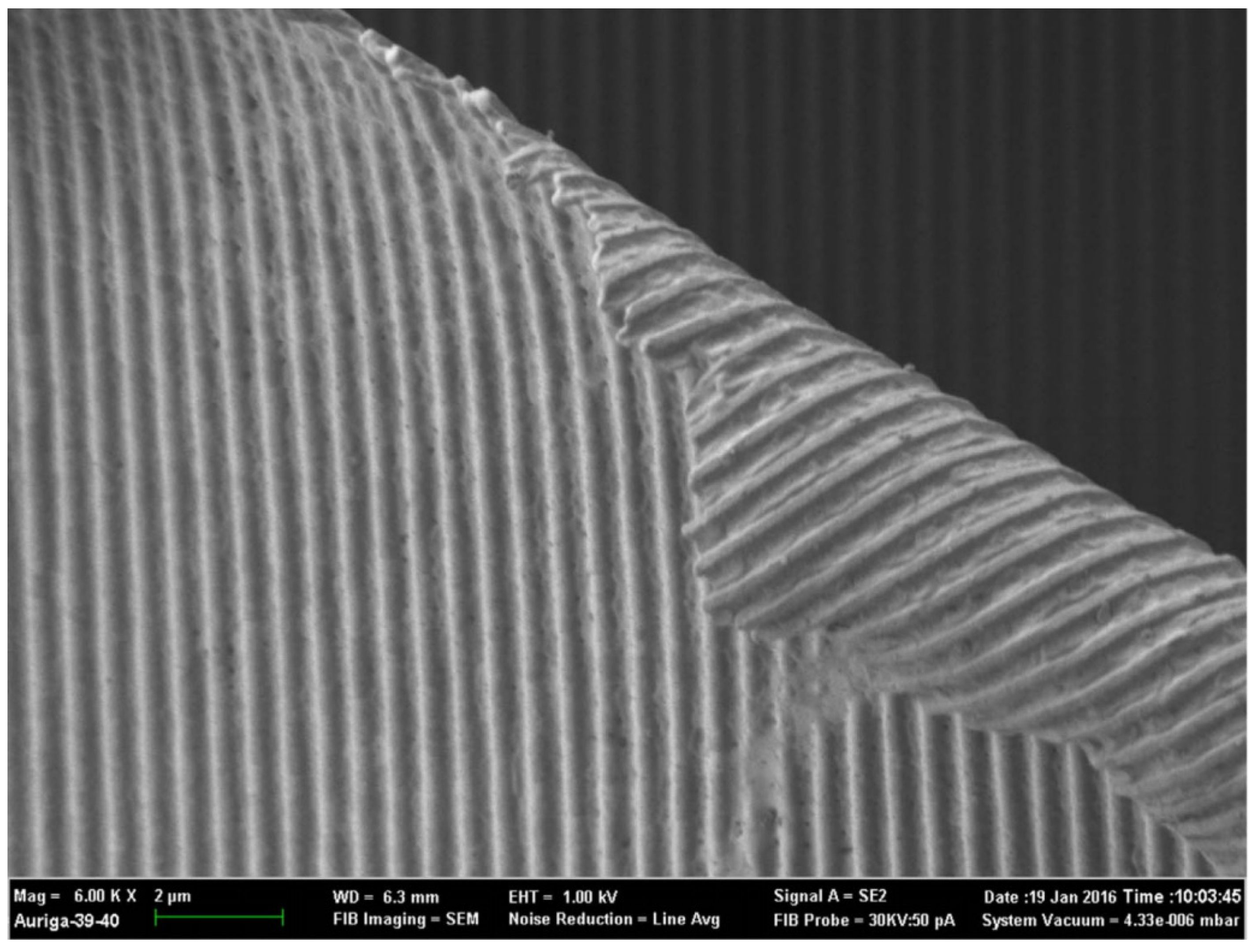

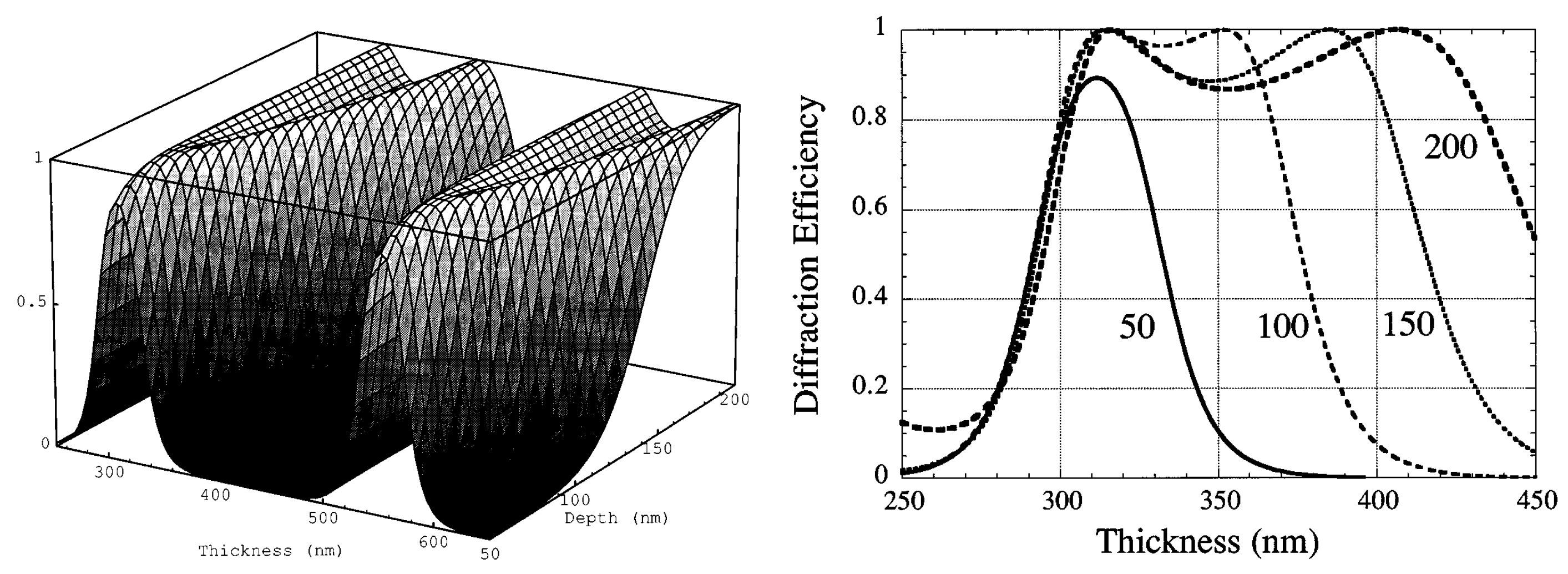
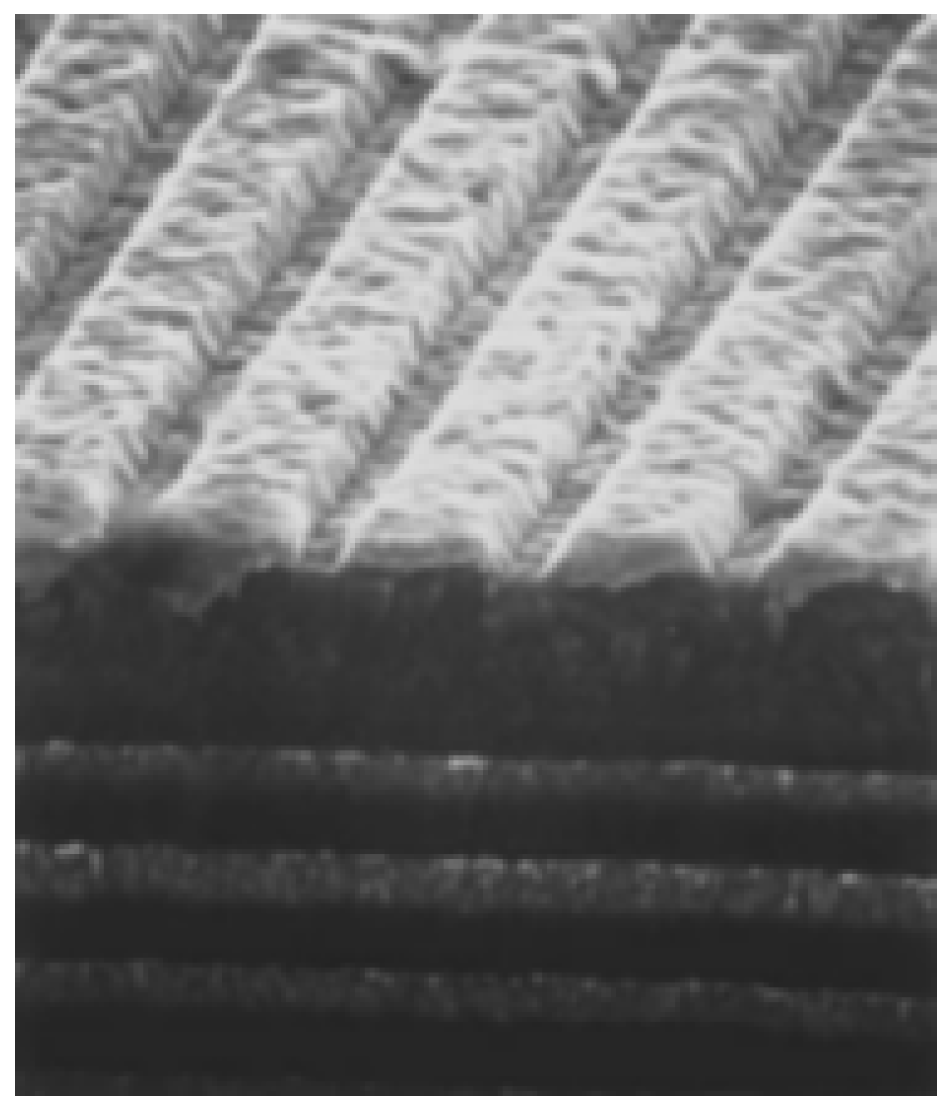

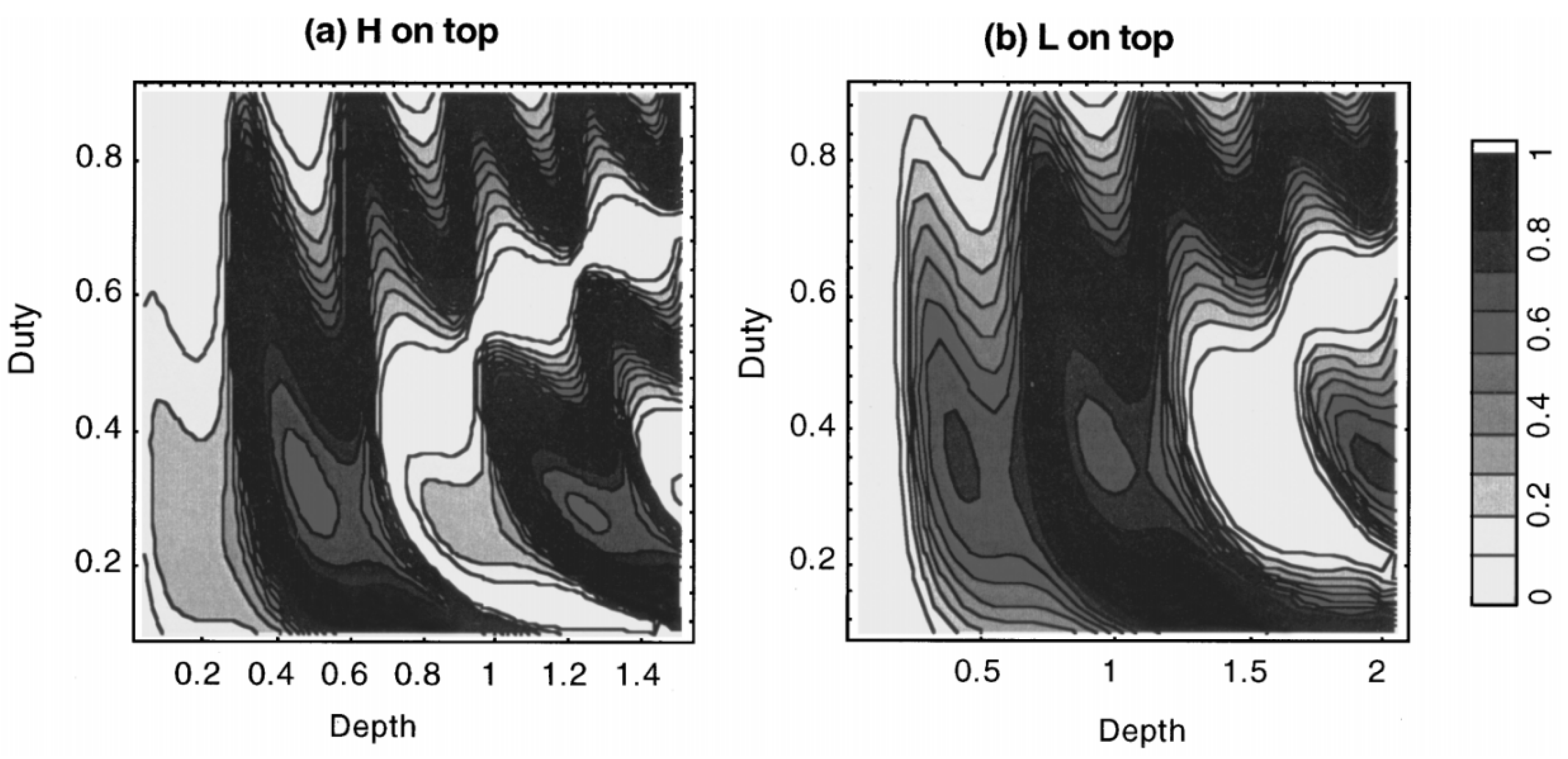
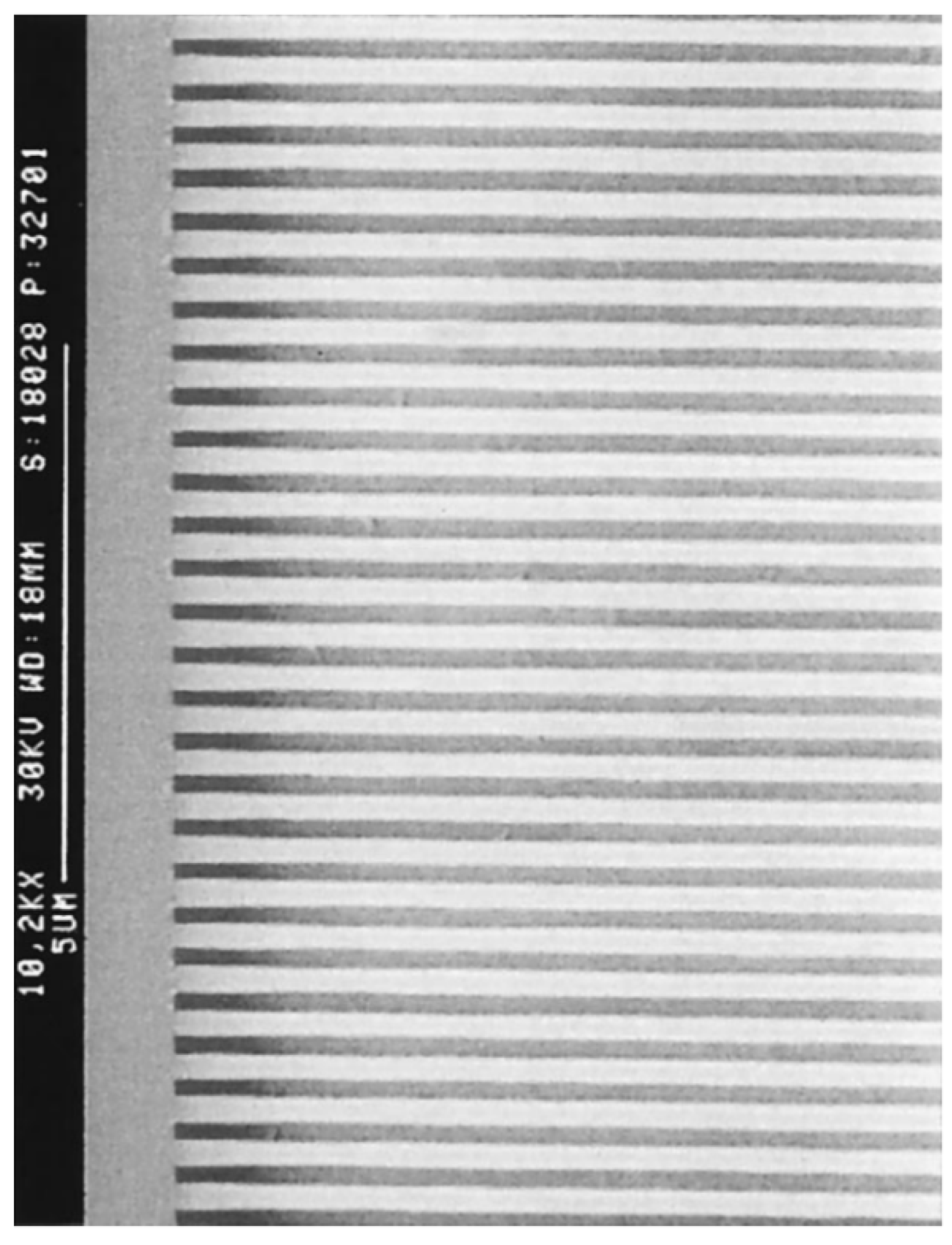
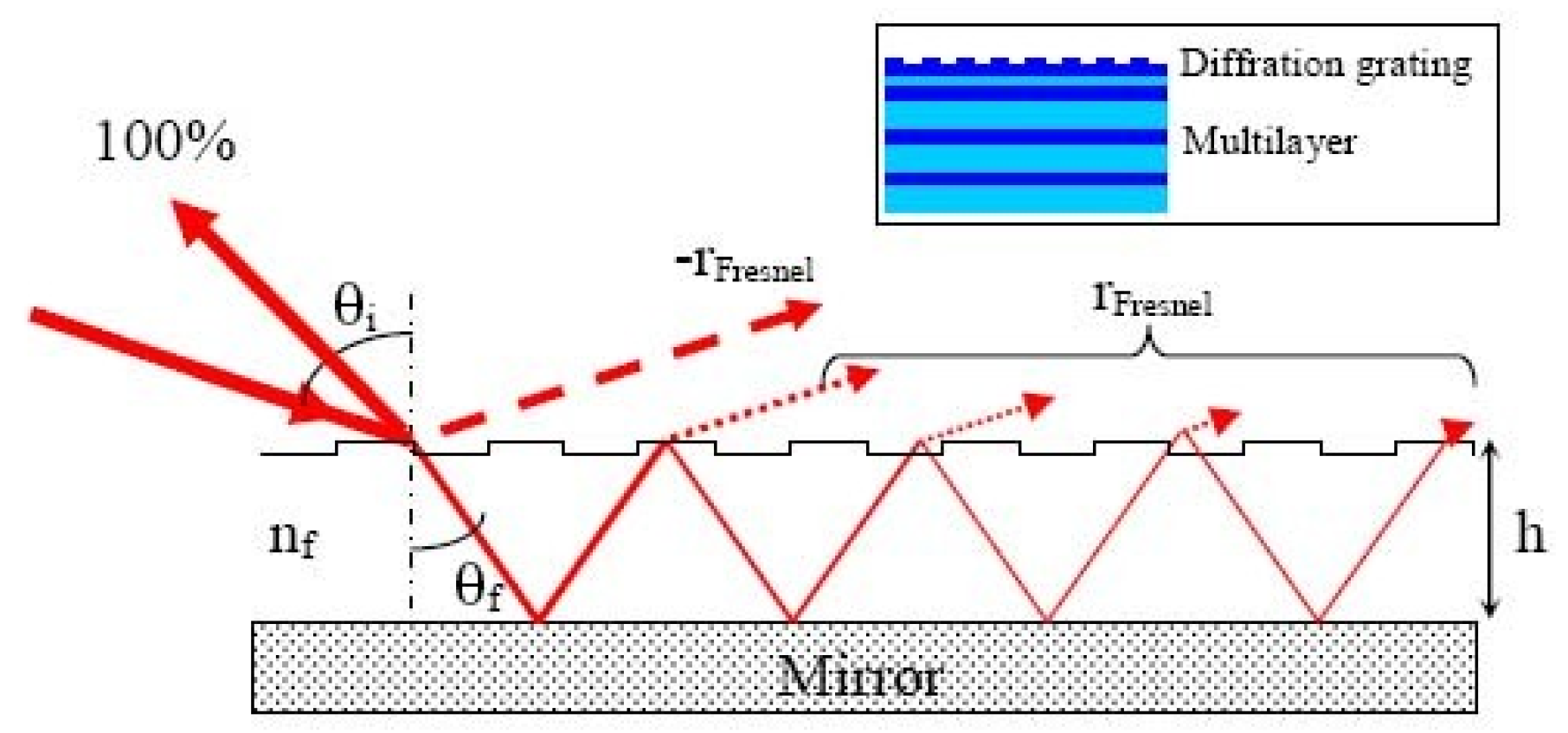
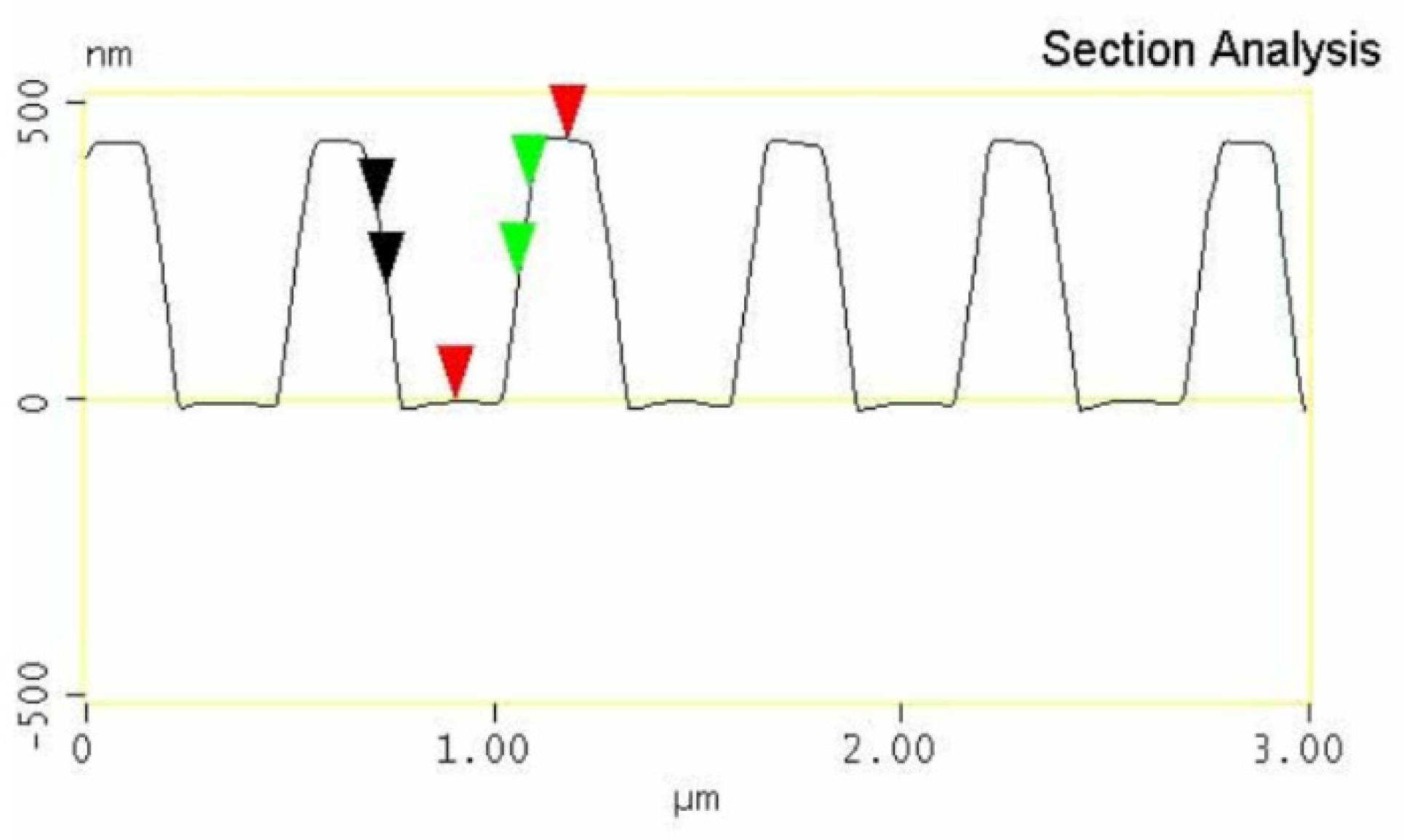
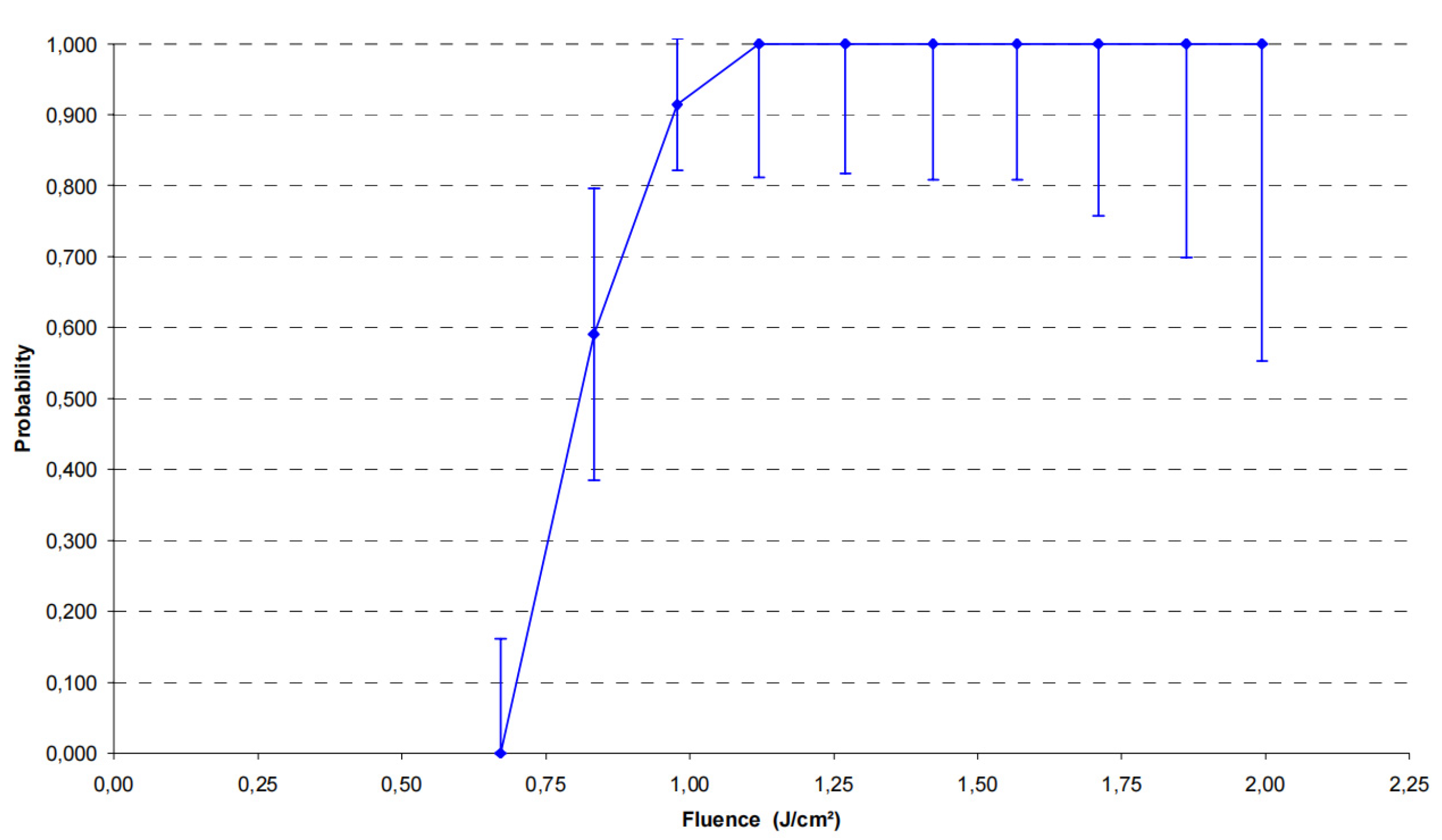
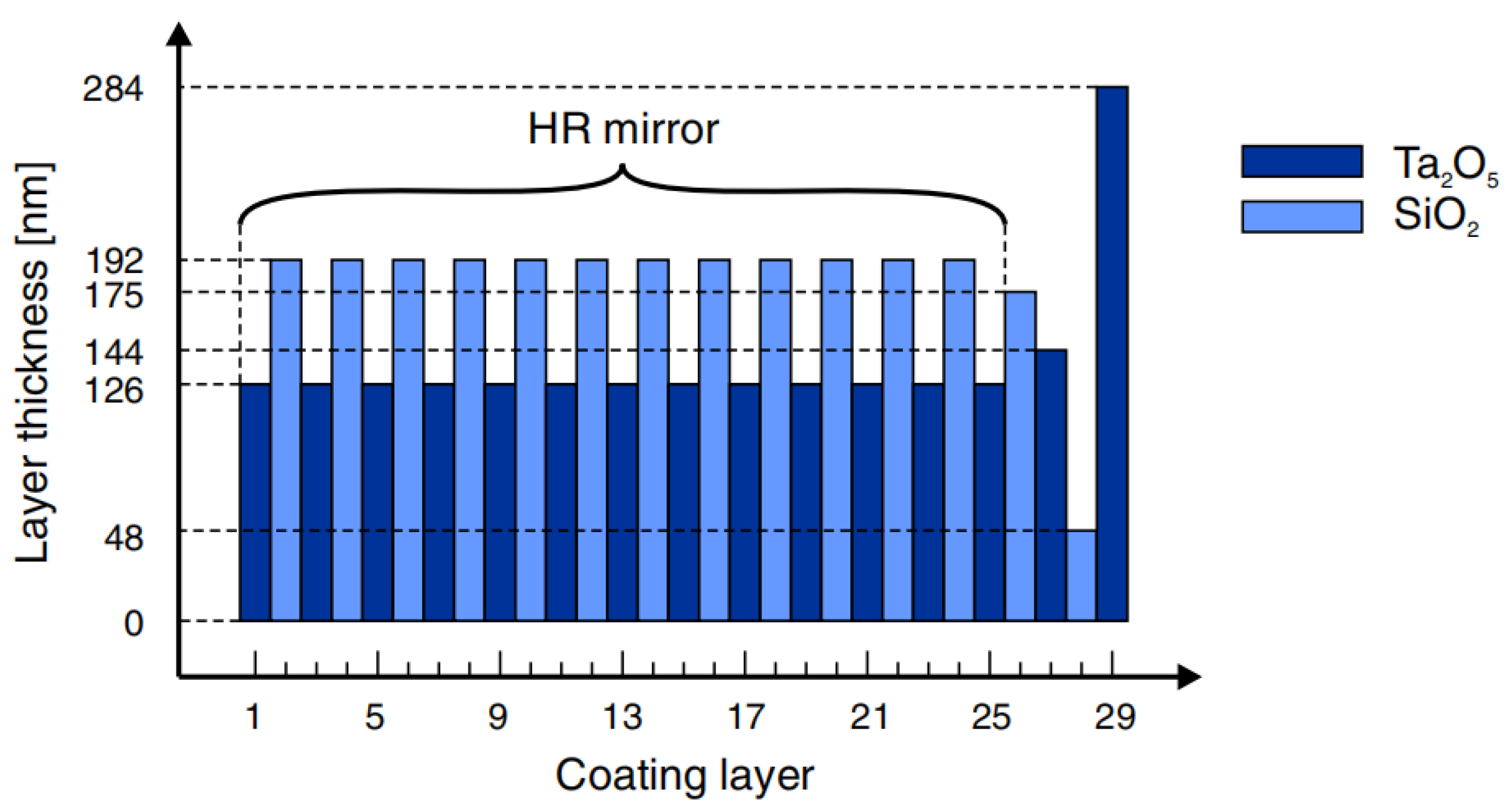



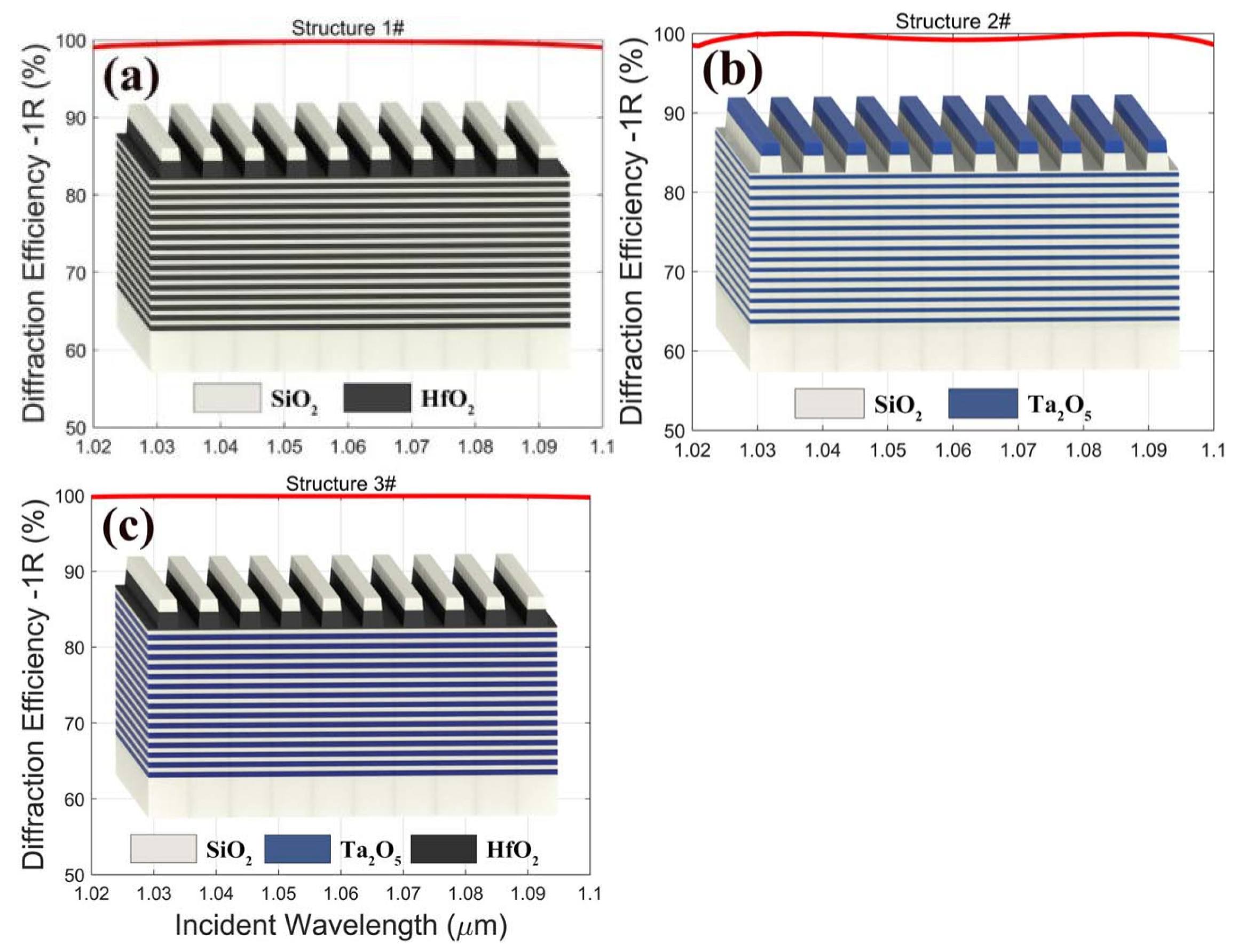

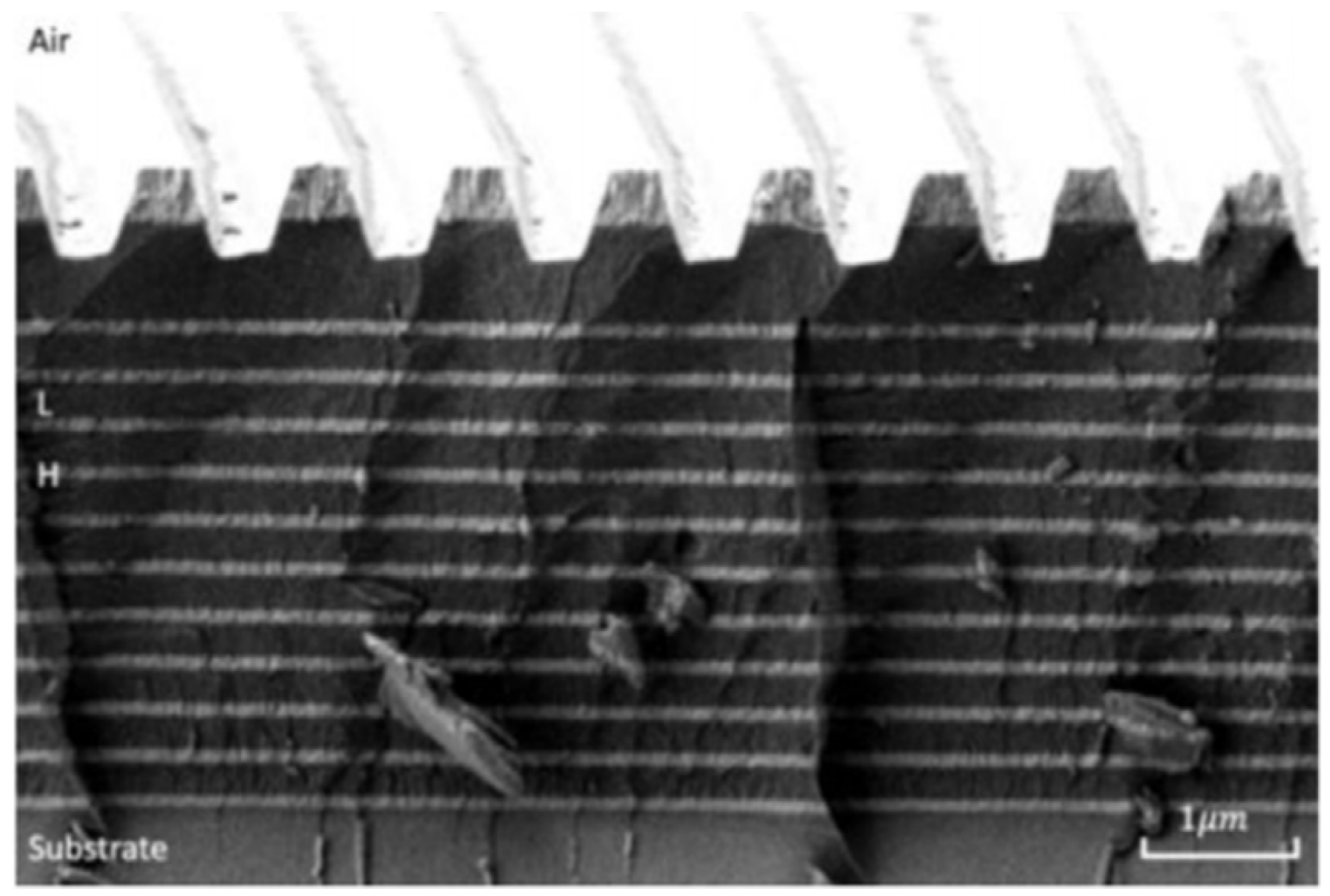
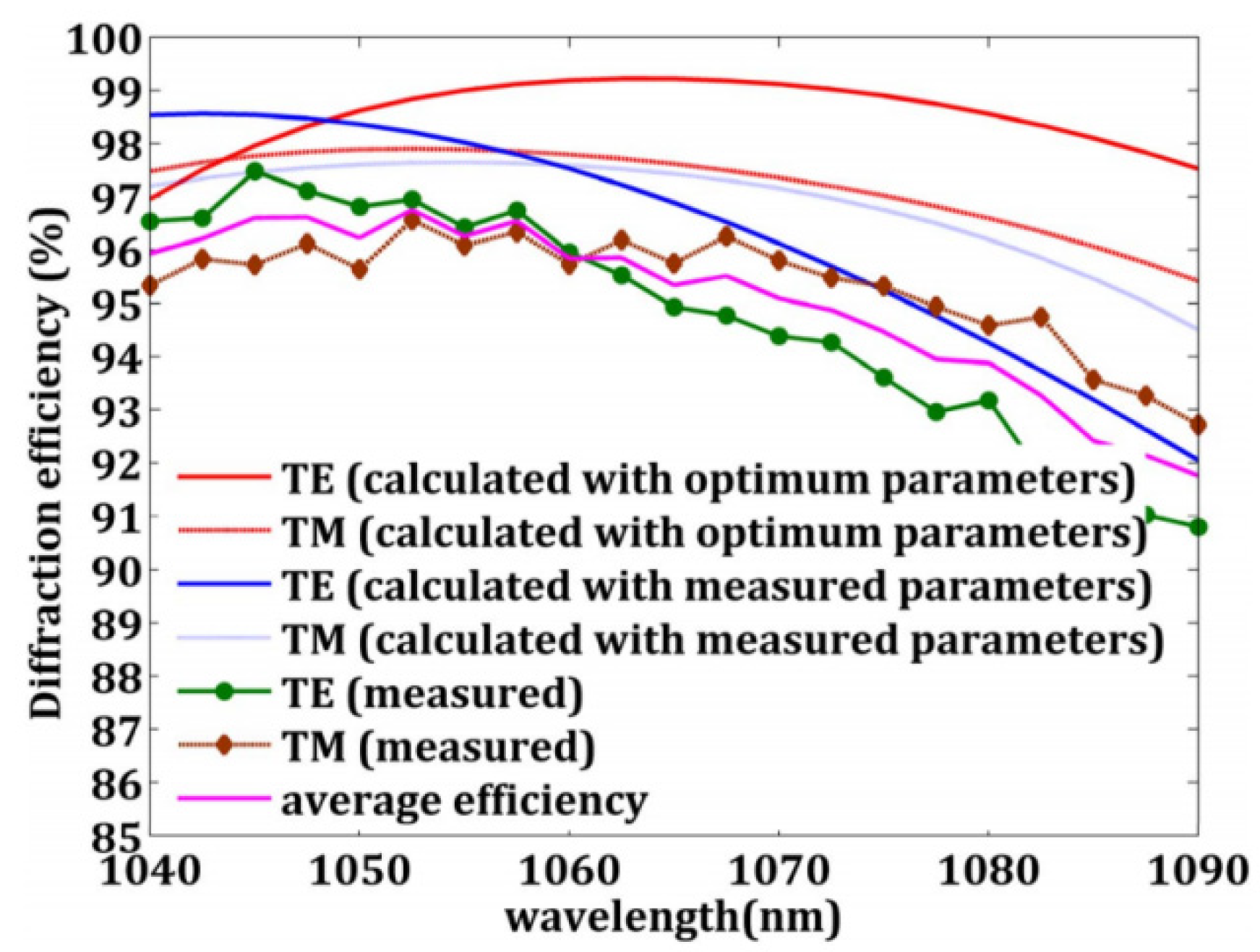


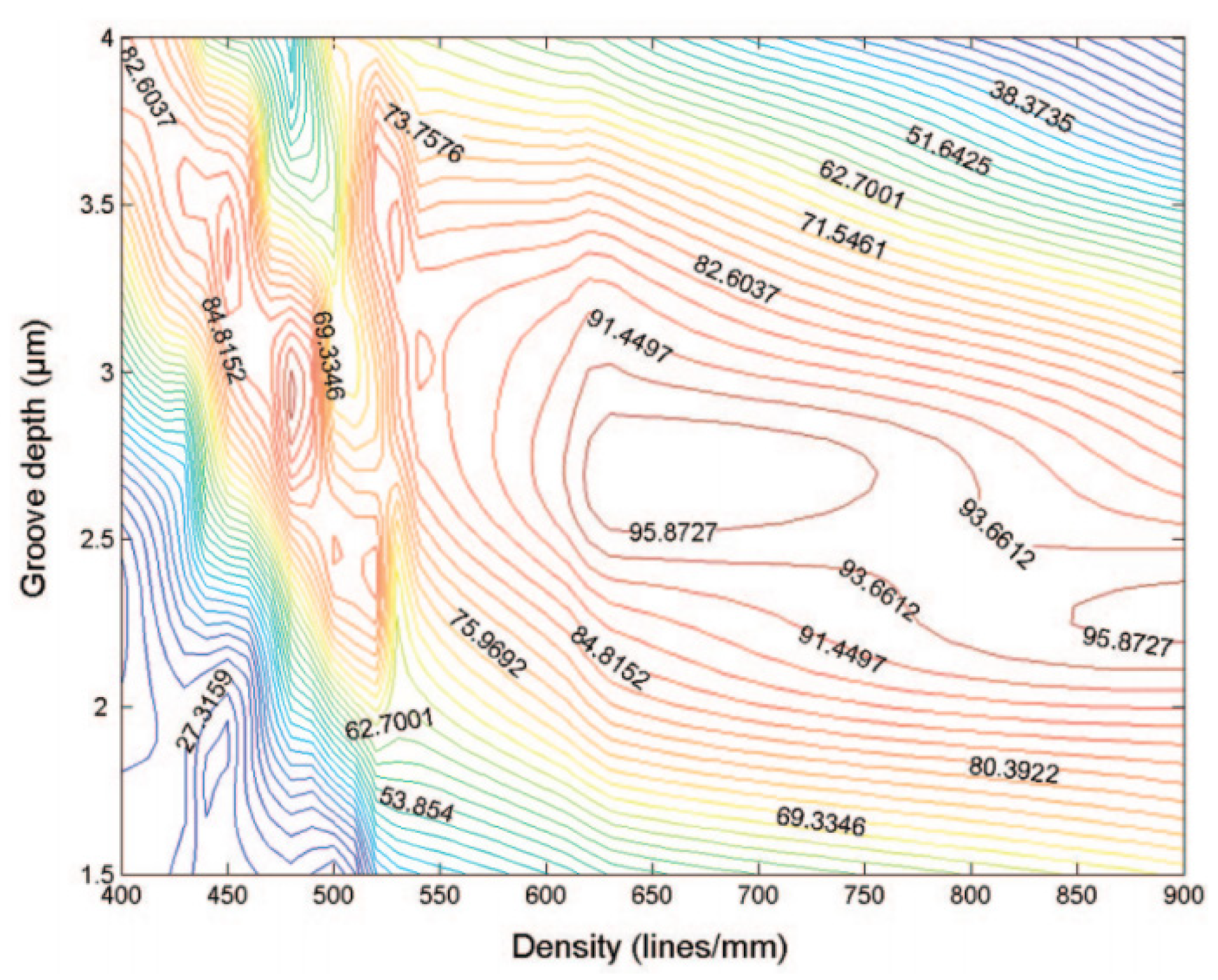

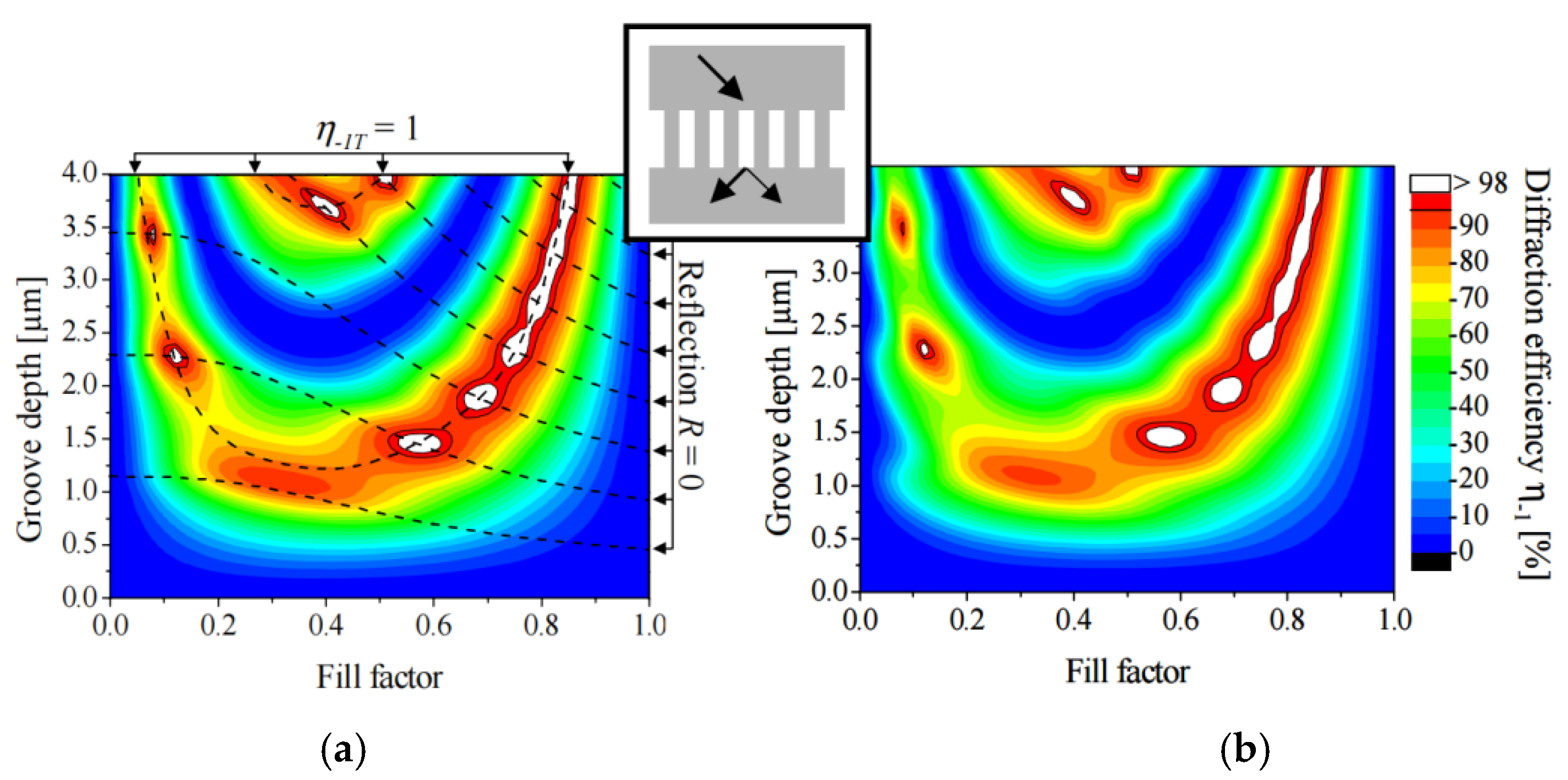


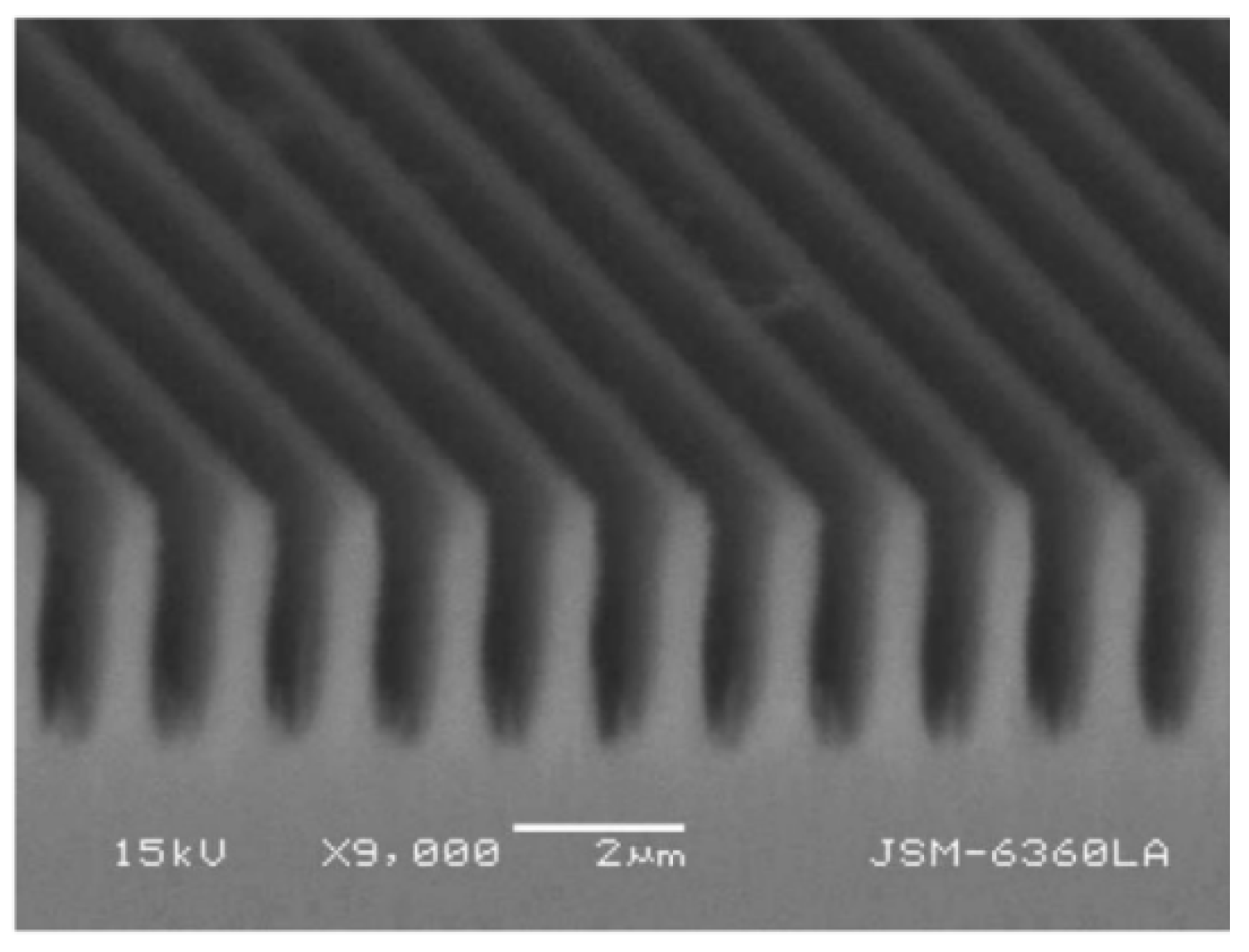
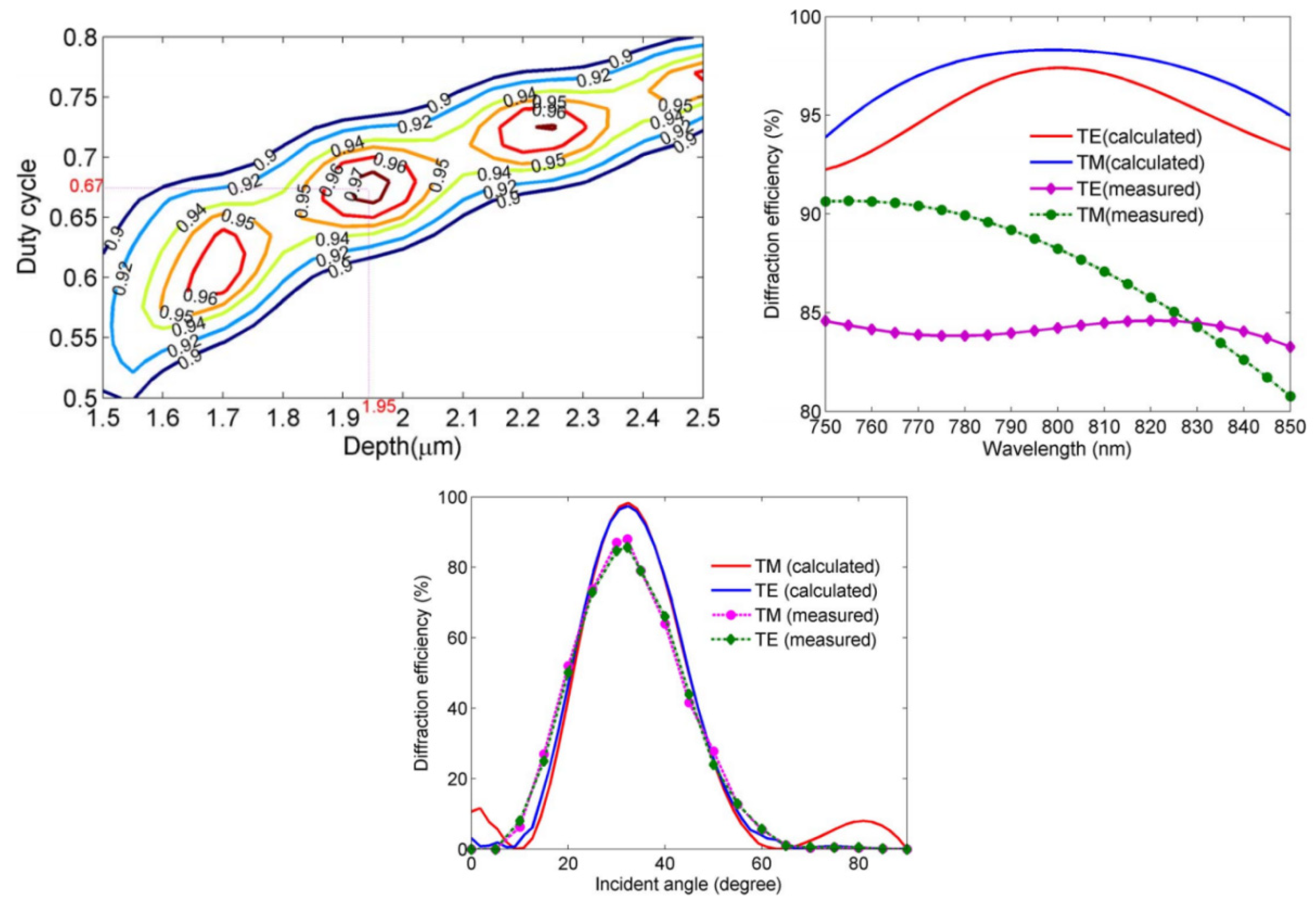
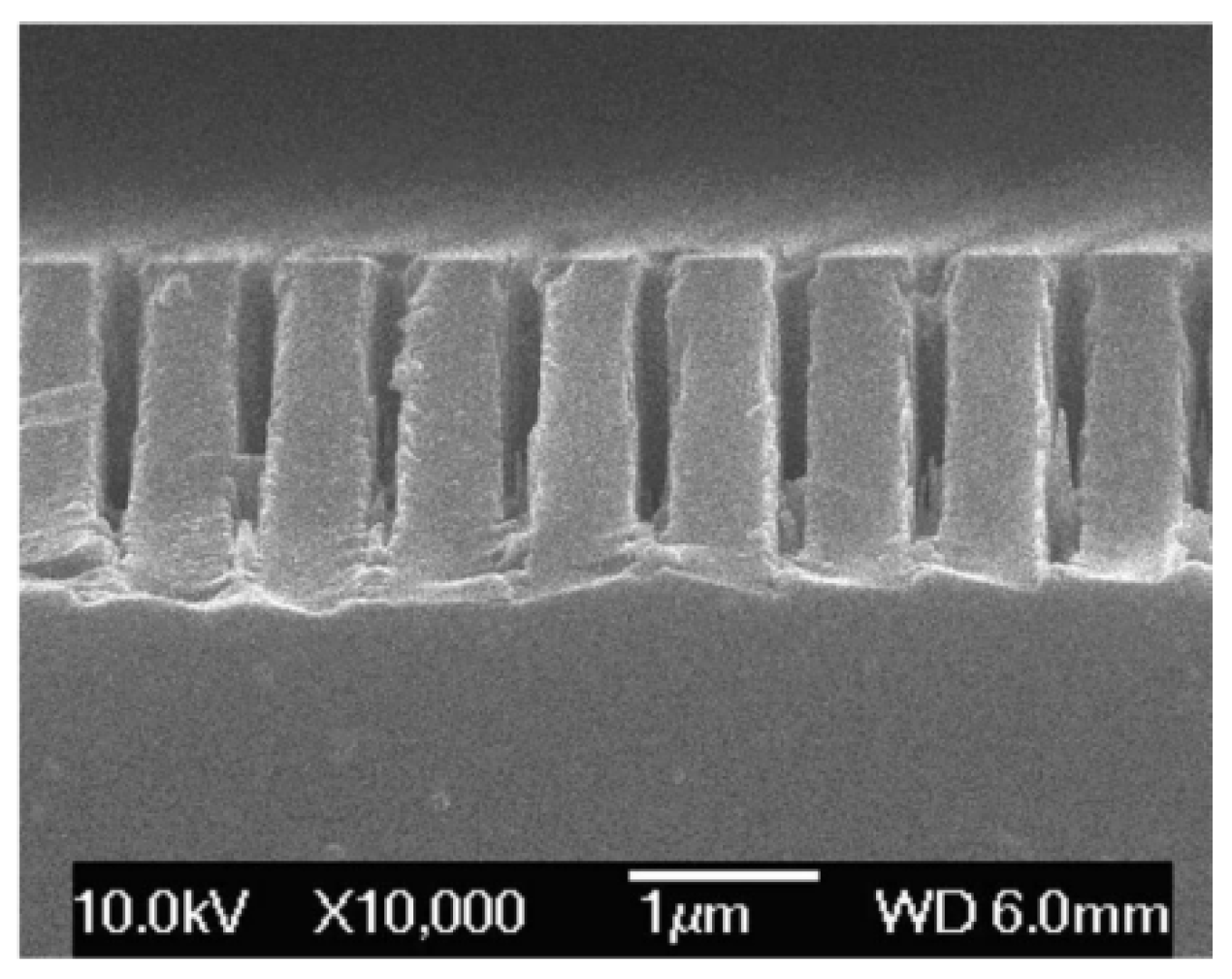
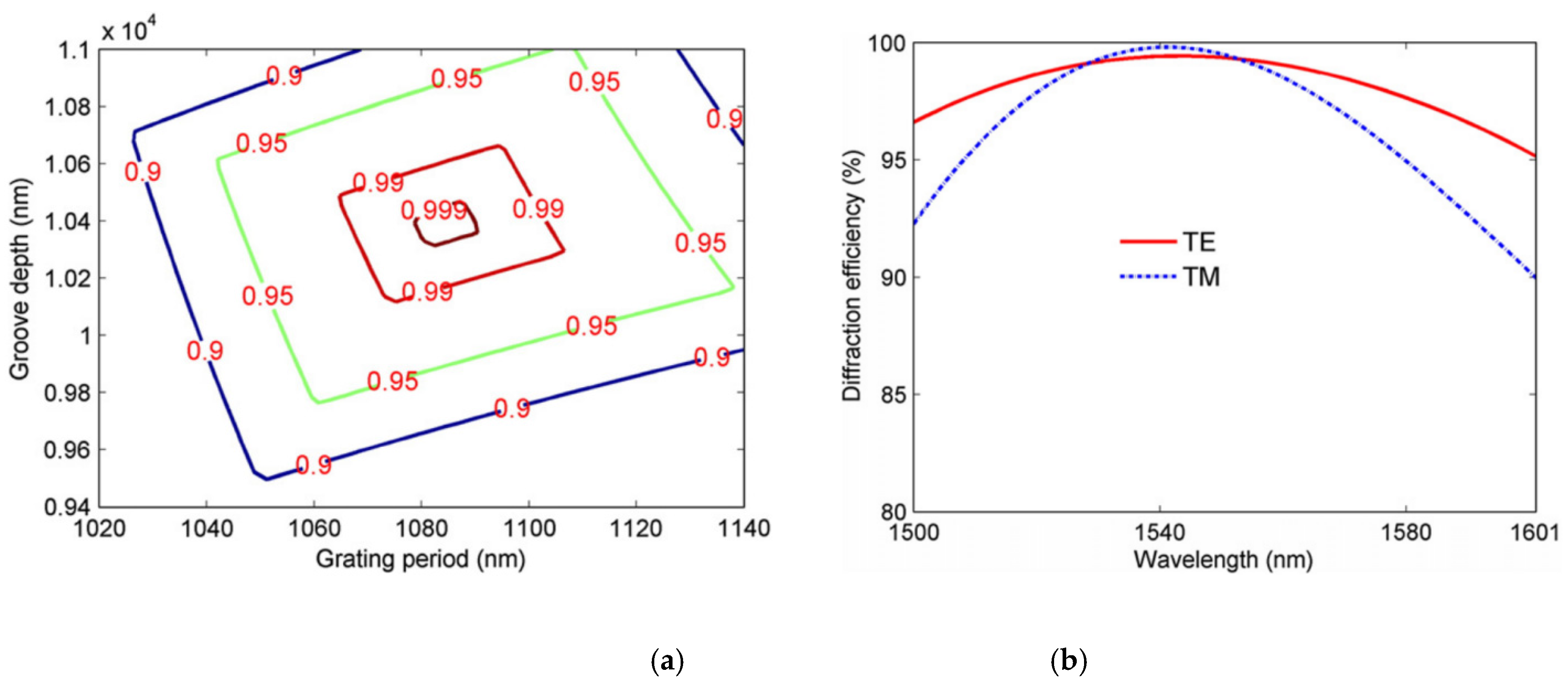
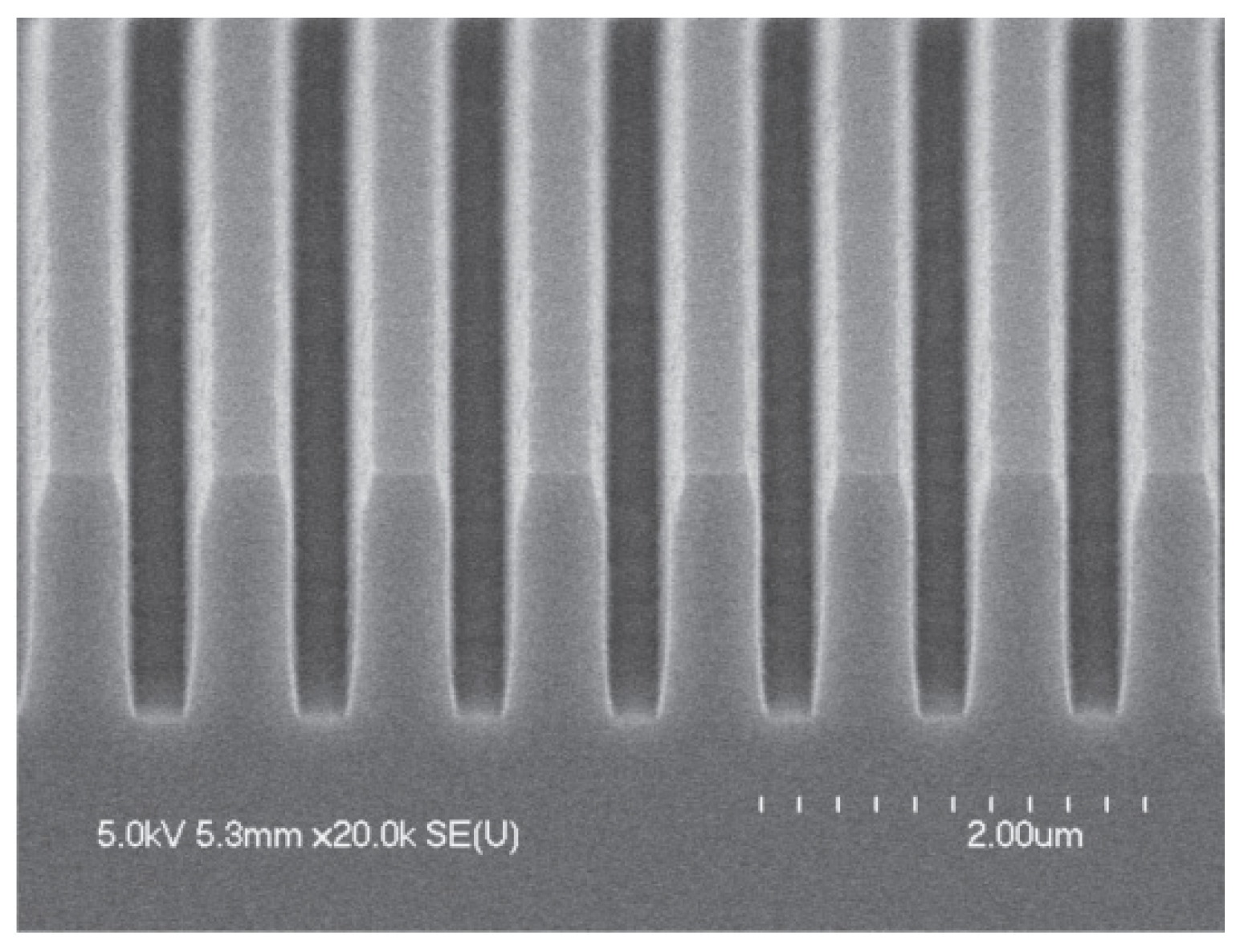
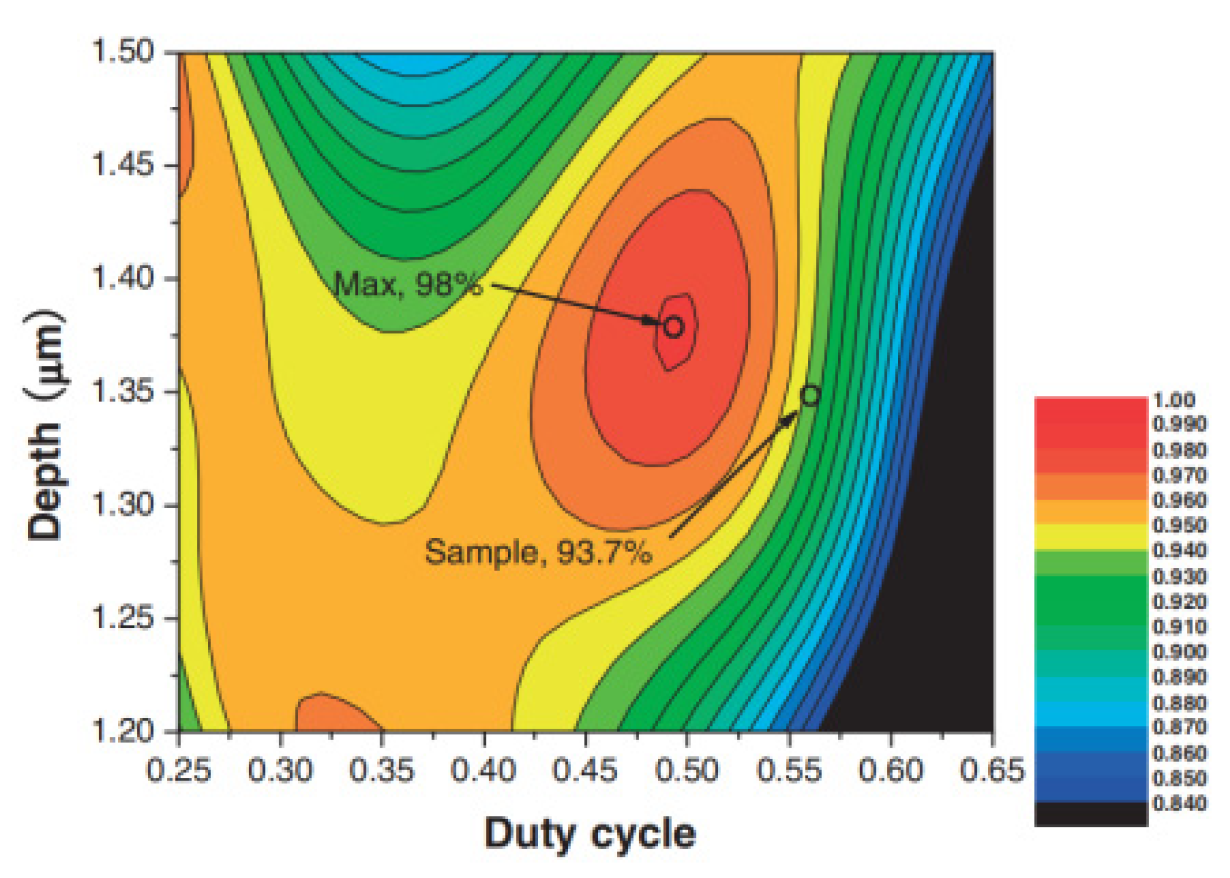


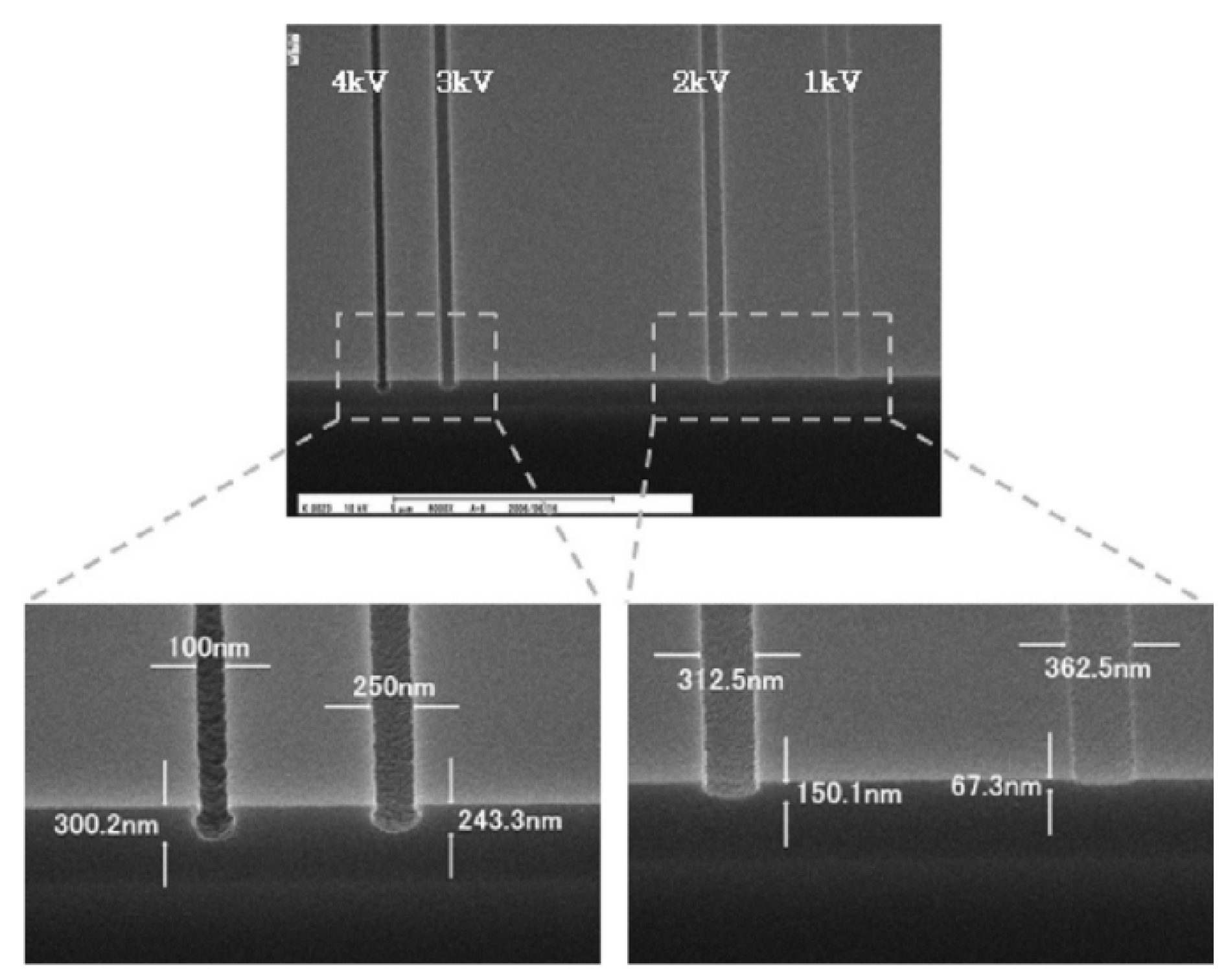
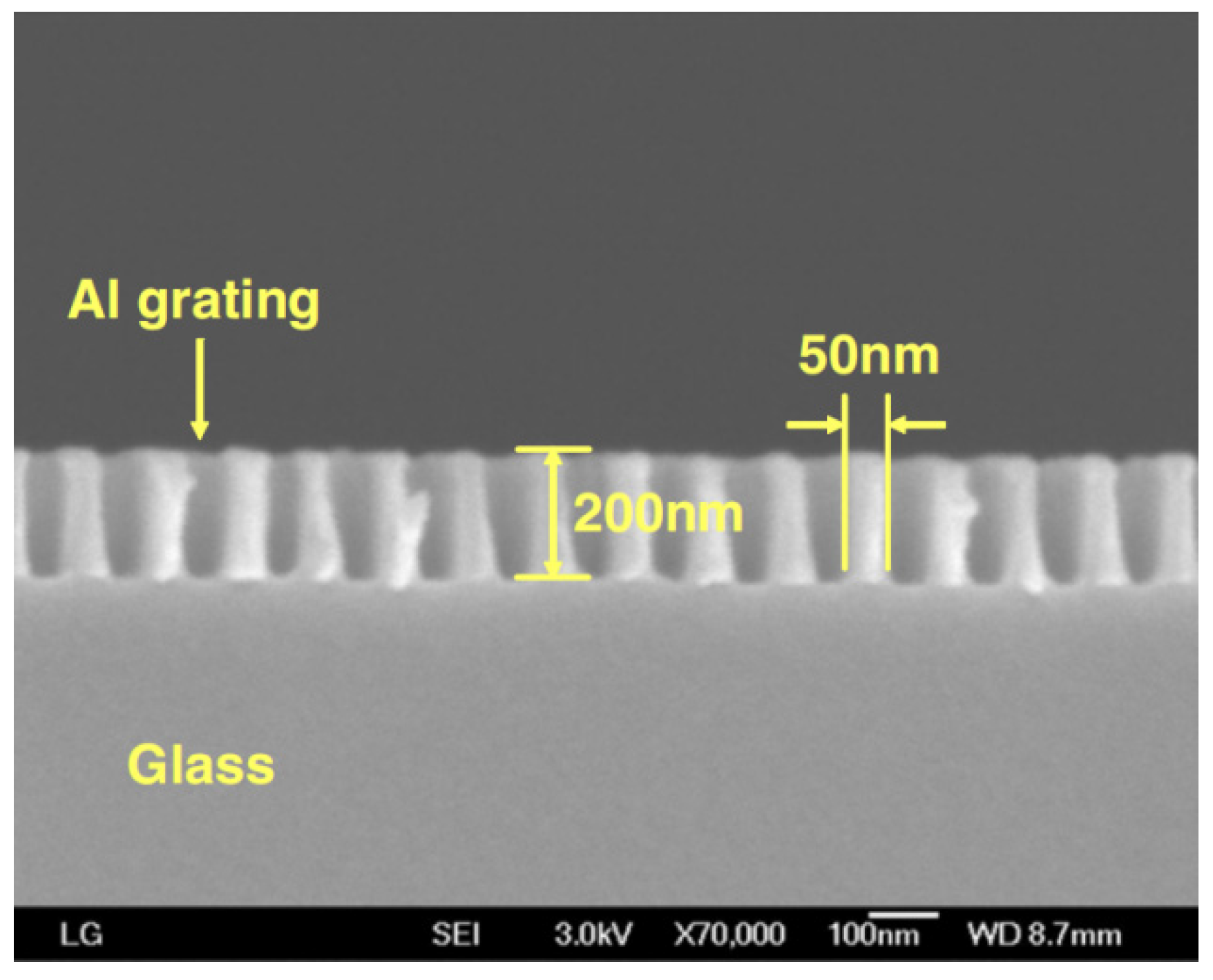
| Years | Units | Structures | Performance |
|---|---|---|---|
| 2008 | Itsunari Yamada, et al. [16] | Period 400 nm, groove depth 350 nm, duty cycle 0.6 | Transmittance TM > 50% (>5 μm), extinction ratio ≈ 20 dB |
| 2010 | Sun Peng, Liu Quan, et al. [17] | Period 200 nm, aluminum 260 nm, duty cycle 0.4 | Transmission efficiency > 45%, extinction ratio > 3.5 × 103 |
| 2012 | Qiufeng Jin, Quan Liu, et al. [18] | Period 500 nm, ridge height 130 nm, Al 120 nm, Cu 50 nm | Transmittance TM > 60% (5–9 μm), extinction ratio ≈ 20 dB (2.5–11 μm) |
| 2014 | Jing Nie, et al. [19] | Au-Si-Au | Transmission TM > 90% |
| 2017 | Zhilin Xia, Haopeng Huang, et al. [20] | Period 574.7 nm, duty cycle 0.82, groove depth 232 nm | DE > 90% @700–1000 nm, LIDT = 0.95 J/cm2 @60 fs |
| 2018 | Yihan Wu, Zhilin Xia, et al. [21] | Period 574.7 nm, groove depth 232 nm, duty cycle 0.82 | −1st DE > 90% @700–1000 nm, LIDT = 0.62 J/cm2 |
| Years | Units | Structures/Contributions | Performance |
|---|---|---|---|
| 1992 | LLNL [27] | MDG proposed for the first time | DE > 98% |
| 1993 | LLNL [28] | First production | DE > 97% @1053 nm |
| 1995 | M. D. Perry, R. D. Boyd, et al. [29] | Line density 1550 gr/mm, multilayer dielectric film (HL)S H, ZnS/ThF4 | −1st order reflection efficiency over 96%, λ0 = 1053 nm, TE mode θLittrow = 56° |
| 1997 | B. W. Shore, M. D. Perry, et al. [30] | Line density 1480 line/mm, duty cycle 0.3, (HLL)n, HfO2/SiO2 | −1st order DE = 95%, λ0 = 1053 nm, TE mode θLittrow =51.2° |
| 1999 | Karl Hehl, Joerg Bischoff, et al. [31] | Period 380 nm, (HL)10 L, Nb2O5/SiO2 | −1st DE = 97%, LIDT = 4.4 J/cm2 @5 ns, λLittrow = 532 nm, TE mode, θi = 45° |
| 2005 | N. Destouches, AV Tishchenko, et al. [33] | Period 560 nm, multilayer dielectric reflective film Ta2O5/SiO2 | −1st DE = 99%, λ0 = 1064 nm, θi = 73° |
| 2007 | J. Neauport, E. Lavastre, et al [34] | 1780 l/mm, multilayer dielectric film (HL) 7H, HfO2/SiO2 | R = 99.5% @1053 nm; LIDT = 0.67 J/cm2, θi = 70.6° |
| 2014 | Martin Rumpel, Michael Moeller, et al. [41] | Line density 1250 line/mm, duty ratio 0.25 | −1st DE = 99.35% @1030 nm, DE = 99.7% @1060 nm, θi = 44°, LIDT = 2.95 J/cm2 @12 ns |
| 2016 | Yifeng Yang [42] | Line density 960 line/mm, | −1st DE > 95% @1040–1090 nm, θi = 30.9°, M2 = 1.9 |
| 2017 | Yunxia Jin, Junming Chen, et al. [43] | Sub+ HR+ Double-Layer Isosceles Trapezoidal Grating Ridges | DE > 98% @1023–1080 nm |
| 2018 | Hongchao Cao, Jun Wu, et al. [45] | Period 900 nm, (HL)14H, HfO2/SiO2, top grating layer 1338 nm | λ0 = 1066 nm, −1st DE = 91% (50 nm), θi = 30.9° |
| 2020 | Chaoming Li, Xinyu Mao, et al. [46] | 1300 gr/mm, Quartz|(HL)16 BGT|C, Ta2O5/SiO2 | λ0 =1065 nm, Littrow structure, −1st DE > 97% (30 nm) |
| Years | Units | Structures/Contributions | Performance |
|---|---|---|---|
| 1983 | R. C. Enger and S. K. Case [47] | Period 330 nm, groove depth 370 nm, | θi = 42°, DE > 88% @632.8 nm |
| 1997 | H. T. Nguyen, B. W. Shore, et al. [48] | Period 350 nm, duty cycle is 0.5, groove depth 600 nm | θLittrow = 30°, TE mode, −1st DE = 98%, LIDT = 13.2 J/cm2 @3 ns |
| 2003 | Tina Clausnitzer, Jens Limpert, et al. [49] | Quartz substrate, period 800 nm, groove depth 1540 nm, duty cycle 0.45 | Λ = 1064 nm, θLittrow = 41.5° DEmax = 97%, LIDT = 2400 J/cm2 @170 ns |
| 2006 | Shunquan Wang, Changhe Zhou, et al. [50] | Duty cycle 0.5, etched groove depth 2500 nm, line density 674 lines/mm | Λ = 1550 nm, DE > 95% |
| 2008 | T. Clausnitzer, T. Kämpfe, et al. [52] | Scribed line density 1670 grooves/mm, duty cycle 0.57, groove depth 1440 nm, | Λ = 1064 nm, DE = 95% |
| 2009 | Jijun Feng, Changhe Zhou, et al. [53] | Period 1216 nm, groove depth 2314 nm | Realize the dual function of 1 × 2 beam splitter, −1st order high-efficiency grating |
| 2010 | Hongchao Cao, Changhe Zhou, et al. [54,55] | Duty cycle 0.67, groove depth 1950 nm | λ = 800 nm, θ0 = 41.5°, DE > 92% (750~850 nm) |
| 2011 | Chun Zhou, Takashi Seki, et al. [56] | Line density 1250 lines/mm, duty cycle 0.49, groove depth 1380 nm | θ0 = 30°, TE mode, λ = 800 nm, DE > 90% (750–850 nm) |
| 2012 | Xufeng Jing, Junchao Zhang, et al. [57] | Deeply etched triangular groove structure | λ = 1064 nm |
| 2013 | Yohei Kobayashi, Nozomi Hirayama, et al. [58] | Line density 1250 line/mm, groove depth 1450 nm, duty cycle 0.45 | DE = 96% |
| 2013 | Bo Wang, Li Chen, et al. [59] | Period 1100 nm, duty cycle 0.6, | λ = 1550 nm, DE > 95% |
| 2020 | Zhengkun Yin, Junjie Yu, et al. [60] | Period 1624.6 nm, duty cycle 0.4 | λ = 1550 nm, −2st Bragg DE > 95% |
| 2021 | Yongfang Xie, Wei Jia, et al. [61] | Period 1270 nm, duty cycle 0.58 | λ = 1550 nm, −1st Littrow DE > 95%, irrelevant loss 0.0013 dB |
Publisher’s Note: MDPI stays neutral with regard to jurisdictional claims in published maps and institutional affiliations. |
© 2022 by the authors. Licensee MDPI, Basel, Switzerland. This article is an open access article distributed under the terms and conditions of the Creative Commons Attribution (CC BY) license (https://creativecommons.org/licenses/by/4.0/).
Share and Cite
Wang, Y.; Fu, X.; Chen, Y.; Qin, L.; Ning, Y.; Wang, L. The Development Progress of Surface Structure Diffraction Gratings: From Manufacturing Technology to Spectroscopic Applications. Appl. Sci. 2022, 12, 6503. https://doi.org/10.3390/app12136503
Wang Y, Fu X, Chen Y, Qin L, Ning Y, Wang L. The Development Progress of Surface Structure Diffraction Gratings: From Manufacturing Technology to Spectroscopic Applications. Applied Sciences. 2022; 12(13):6503. https://doi.org/10.3390/app12136503
Chicago/Turabian StyleWang, Ye, Xiuhua Fu, Yongyi Chen, Li Qin, Yongqiang Ning, and Lijun Wang. 2022. "The Development Progress of Surface Structure Diffraction Gratings: From Manufacturing Technology to Spectroscopic Applications" Applied Sciences 12, no. 13: 6503. https://doi.org/10.3390/app12136503
APA StyleWang, Y., Fu, X., Chen, Y., Qin, L., Ning, Y., & Wang, L. (2022). The Development Progress of Surface Structure Diffraction Gratings: From Manufacturing Technology to Spectroscopic Applications. Applied Sciences, 12(13), 6503. https://doi.org/10.3390/app12136503









